文章
Colorful
2017年05月23日
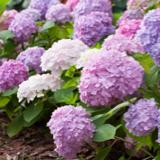
New to growing plants and no idea what you should grow indoors? Learn about these 15 Best Houseplants for Beginners. They all are easy to grow!
Potted houseplants provide a lavish look and can be used to decorate the interior at low cost. Also, they create positive impact and many of them purify the air. But what you’ll do if you don’t have much knowledge about growing plants and the houseplants that are best to grow? Simple! Learn about these 15 Best Houseplants for Beginners! They are easy to grow and tolerate poor conditions.
1. Snake Plant
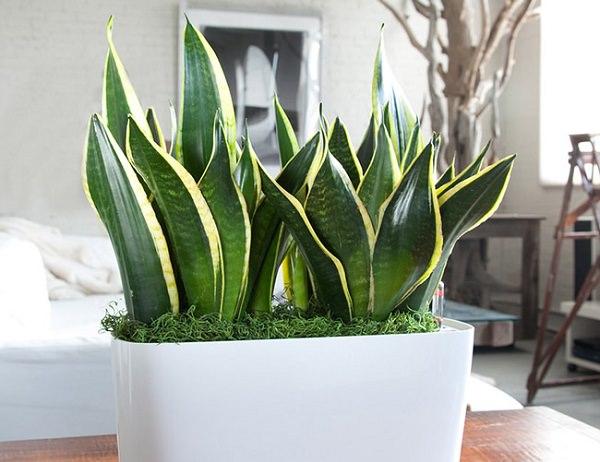
Snake plant is one of the best plants for the beginners. Easy to grow and hard to kill, it can be grown in low light and need to be watered occasionally. Snake plant also removes toxins from the air– All this makes it a perfect houseplant for beginners.
2. Heartleaf Philodendron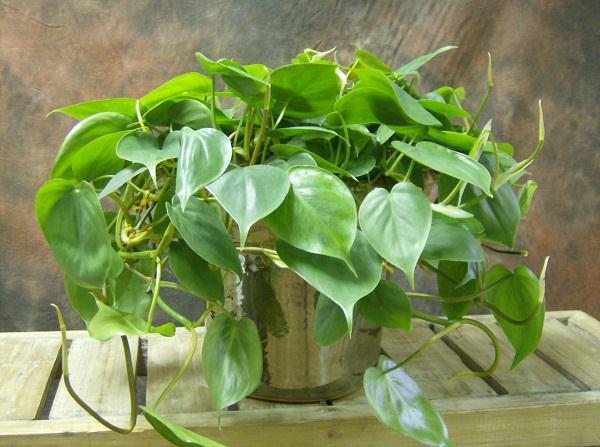
Philodendron scandens is extremely easy to grow and great for beginners. It needs a moderate amount of light and prefers the soil to dry out between watering spells.
3. Spider Plant
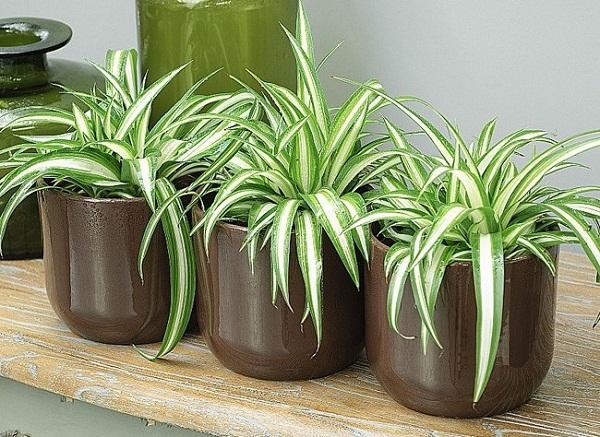
One of the most popular houseplants. Its popularity is due to its toughness and the ease of growing and maintenance. The plant can easily adapt to almost any condition. Keep the plant in a bright spot and maintain slight moisture in the soil and it will grow happily.
4. Peace Lily

The peace lily is among the easiest plants to grow indoors. It can tolerate a wide range of lighting conditions, and needs only moderate watering. With graceful curving leaves and white flower that rise up from the dark foliage, peace lily looks exotic and elegant.
5. English Ivy
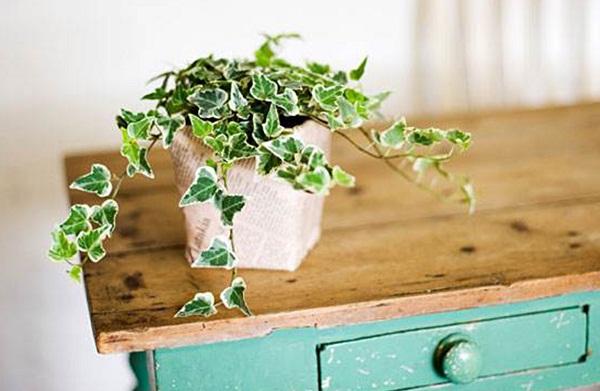
English Ivy is very hardy and easy to grow. Keep the pot in a spot that receives bright indirect sun and plant it in a container that is wide and shallow rather than narrow and deep.
6. Succulents and Cactus
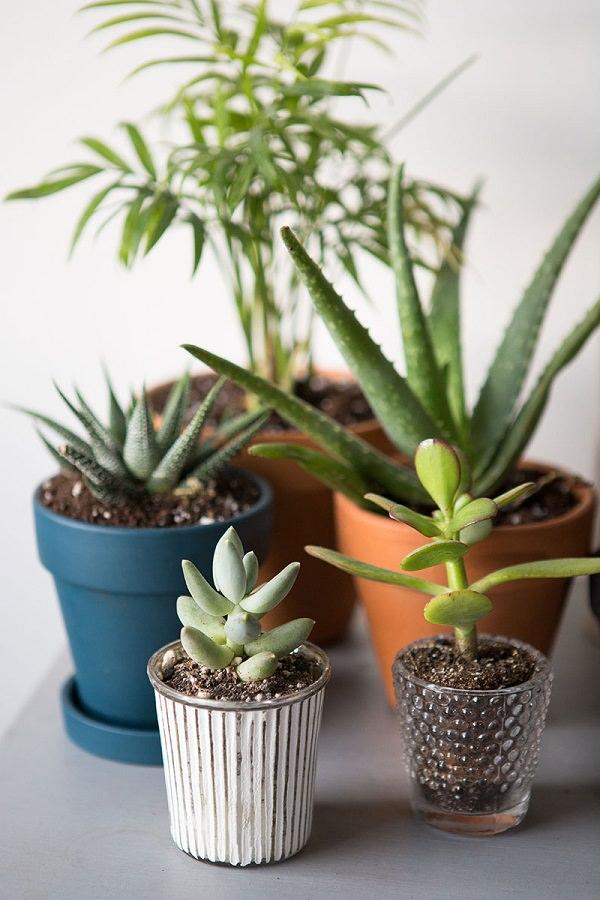
Succulents and cacti are ideal for those who forget to water and care for plants. They are very adaptable and can survive many adverse conditions.
They need to be placed on a bright spot and a well-drained soil with little water.
7. Lucky Bamboo
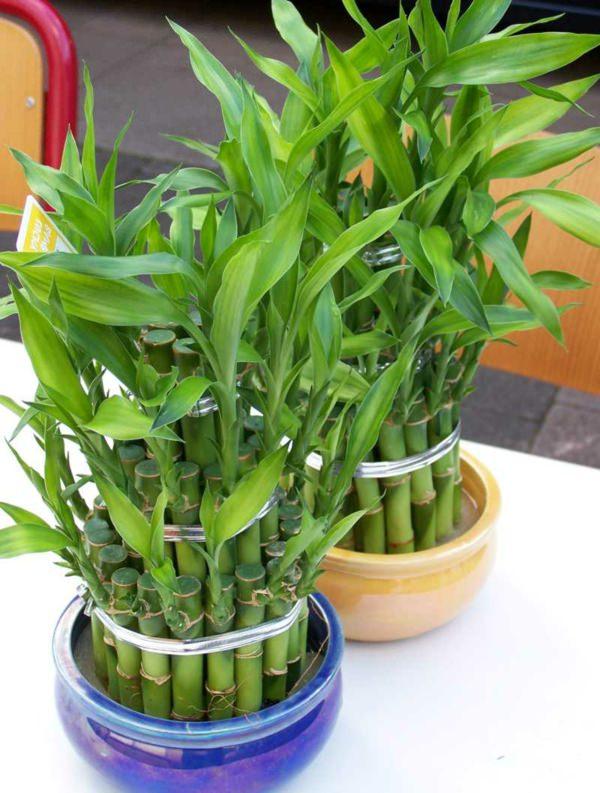
Lucky bamboo is not a bamboo, but a plant belongs to Dracaena genus. It is an easy-care houseplant. Just provide it abundant water and it’ll grow well even in indirect light. Protect the plant from cold drafts and provide iron fertilizer occasionally.
8. Jade Plant
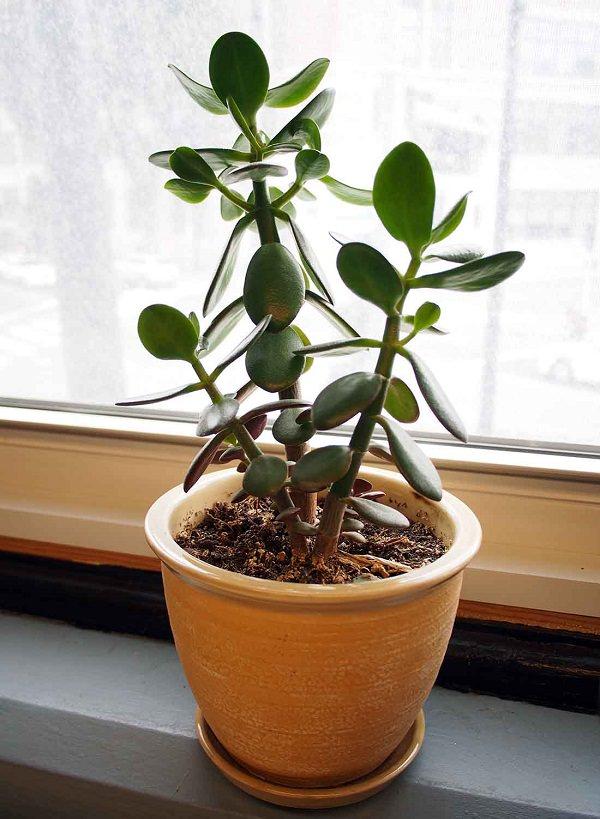
Jade plant is a succulent and is probably one of the best houseplants for beginners. When grown indoors, a jade plant can grow up to a size of a small shrub. Keep the plant in a spot that receives partial or indirect sunlight from having a healthy specimen.
9. Cast Iron Plant
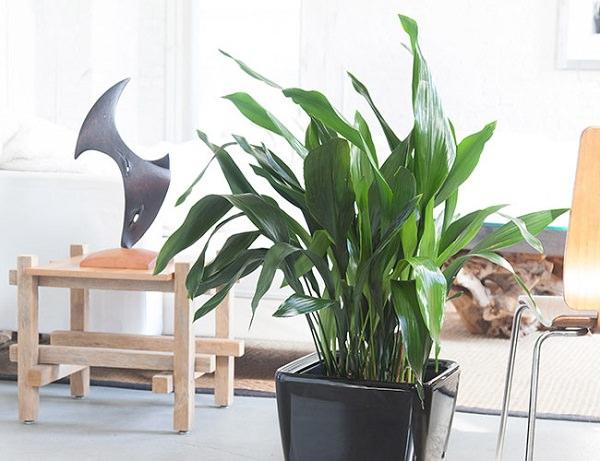
As the name suggest, one of the toughest plants that make it ideal for beginners. Cast-iron plant can withstands neglect, low light, low humidity, and a wide range of temperatures. It prefers moist soil.
10. Peperomia

Credit: Houseplants Expert
Another good plant for beginners is Peperomia. Peperomia is small striking houseplant that is available in different colors and shapes. Peperomia likes slightly moist soil and humidity but watering should be reduced in winter.
11. ZZ Plant

This super-tough plant is high resistant to adverse conditions like drought and low light. The plant prefers bright to moderate indirect light and well-drained soil. ZZ plant can do fine without fertilizer, but if you would like, you can fertilize the plant with half strength general fertilizer one to two times a year in the summer months.
12. Pothos (Devil’s Ivy)
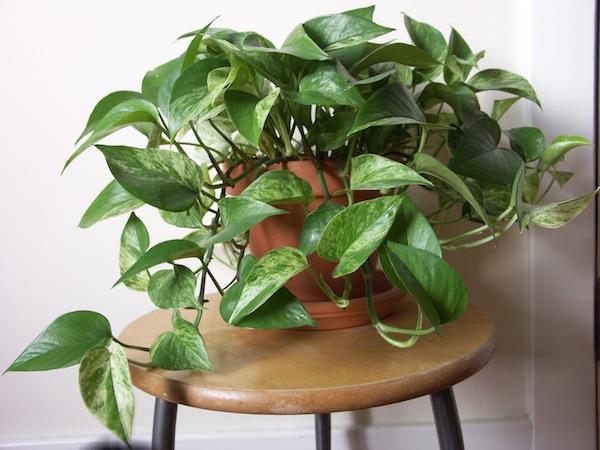
Plants of the pothos family are easy to grow and become great houseplants for beginners. This attractive and durable vine prefers bright indirect light and a draft free place. It can grow in low light and needs moist soil.
13. Dracaena

There are many varieties of Dracaena genus that are hardy houseplants, Dracaena marginata, Dracaena fragrans are among the most popular and easy to grow plants. This beautiful houseplant needs occasional pruning and regular watering. Keep the plant away from direct sun and avoid overwatering.
14. Bromeliads

Bromeliad is a perfect plant to grow indoors, most of the varieties of this plant thrive easily indoors. Although it is difficult to make it bloom, there are many varieties that have beautiful foliage that makes an attractive display.
15. Rubber Plant
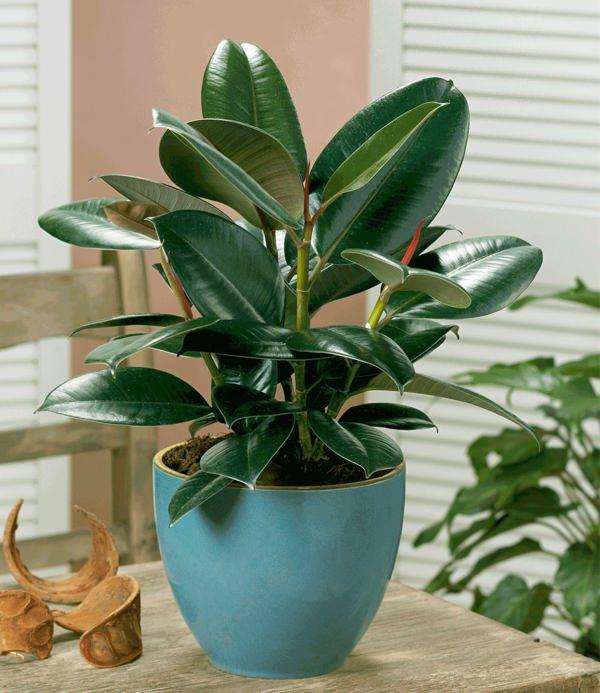
Rubber plant is a large houseplant that can become a focal point to any room. Low maintenance and easy to grow. Keep it in a well-lit position in your home and allow the soil to dry out between watering spells. Besides the ornamental aspect, rubber plant is also an air purifying plant.
Potted houseplants provide a lavish look and can be used to decorate the interior at low cost. Also, they create positive impact and many of them purify the air. But what you’ll do if you don’t have much knowledge about growing plants and the houseplants that are best to grow? Simple! Learn about these 15 Best Houseplants for Beginners! They are easy to grow and tolerate poor conditions.
1. Snake Plant

Snake plant is one of the best plants for the beginners. Easy to grow and hard to kill, it can be grown in low light and need to be watered occasionally. Snake plant also removes toxins from the air– All this makes it a perfect houseplant for beginners.
2. Heartleaf Philodendron

Philodendron scandens is extremely easy to grow and great for beginners. It needs a moderate amount of light and prefers the soil to dry out between watering spells.
3. Spider Plant

One of the most popular houseplants. Its popularity is due to its toughness and the ease of growing and maintenance. The plant can easily adapt to almost any condition. Keep the plant in a bright spot and maintain slight moisture in the soil and it will grow happily.
4. Peace Lily

The peace lily is among the easiest plants to grow indoors. It can tolerate a wide range of lighting conditions, and needs only moderate watering. With graceful curving leaves and white flower that rise up from the dark foliage, peace lily looks exotic and elegant.
5. English Ivy

English Ivy is very hardy and easy to grow. Keep the pot in a spot that receives bright indirect sun and plant it in a container that is wide and shallow rather than narrow and deep.
6. Succulents and Cactus

Succulents and cacti are ideal for those who forget to water and care for plants. They are very adaptable and can survive many adverse conditions.
They need to be placed on a bright spot and a well-drained soil with little water.
7. Lucky Bamboo

Lucky bamboo is not a bamboo, but a plant belongs to Dracaena genus. It is an easy-care houseplant. Just provide it abundant water and it’ll grow well even in indirect light. Protect the plant from cold drafts and provide iron fertilizer occasionally.
8. Jade Plant

Jade plant is a succulent and is probably one of the best houseplants for beginners. When grown indoors, a jade plant can grow up to a size of a small shrub. Keep the plant in a spot that receives partial or indirect sunlight from having a healthy specimen.
9. Cast Iron Plant

As the name suggest, one of the toughest plants that make it ideal for beginners. Cast-iron plant can withstands neglect, low light, low humidity, and a wide range of temperatures. It prefers moist soil.
10. Peperomia

Credit: Houseplants Expert
Another good plant for beginners is Peperomia. Peperomia is small striking houseplant that is available in different colors and shapes. Peperomia likes slightly moist soil and humidity but watering should be reduced in winter.
11. ZZ Plant

This super-tough plant is high resistant to adverse conditions like drought and low light. The plant prefers bright to moderate indirect light and well-drained soil. ZZ plant can do fine without fertilizer, but if you would like, you can fertilize the plant with half strength general fertilizer one to two times a year in the summer months.
12. Pothos (Devil’s Ivy)

Plants of the pothos family are easy to grow and become great houseplants for beginners. This attractive and durable vine prefers bright indirect light and a draft free place. It can grow in low light and needs moist soil.
13. Dracaena

There are many varieties of Dracaena genus that are hardy houseplants, Dracaena marginata, Dracaena fragrans are among the most popular and easy to grow plants. This beautiful houseplant needs occasional pruning and regular watering. Keep the plant away from direct sun and avoid overwatering.
14. Bromeliads

Bromeliad is a perfect plant to grow indoors, most of the varieties of this plant thrive easily indoors. Although it is difficult to make it bloom, there are many varieties that have beautiful foliage that makes an attractive display.
15. Rubber Plant

Rubber plant is a large houseplant that can become a focal point to any room. Low maintenance and easy to grow. Keep it in a well-lit position in your home and allow the soil to dry out between watering spells. Besides the ornamental aspect, rubber plant is also an air purifying plant.
0
2
文章
扭扭
2017年05月23日

Learn how to grow cucumbers vertically to get the most productive plant. Growing cucumbers vertically also save lot of space, which is suitable for small gardens.
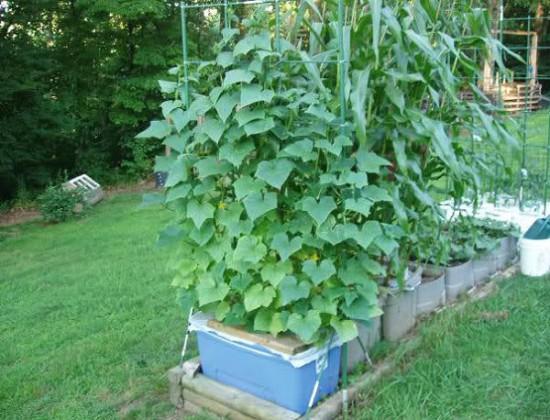
Cucumber is a refreshing vegetable, especially if picked up fresh. It is eaten in variety of ways: raw in salad, cooked or pickled. It is easy to grow and only requires a warm, sunny exposure and deep and regular watering.
What if you want to grow cucumbers but you have a small garden. Definitely, it will take a lot of space. In that case growing cucumbers vertically is an space savvy option.
Benefits of Growing Cucumbers Vertically
One advantage of Growing Cucumbers Vertically is that by this you can avoid a common problem of fruit rot associated with cucumber cultivation, which happens when fruit sitting in moist soil for long period of time. When you allow cucumber vines to grow up vertically, it improves the air circulation around the plant that prevents fungal diseases. Cucumber plants have sprawling habit and growing cucumbers vertically allow their leaves to absorb more sun, which result in healthy plant and large cucumbers. One more key benefit is that you can harvest the fruits more easily and in time.
Why you should grow cucumbers vertically
When cucumbers grown horizontally they usually cover 10 – 20 sq ft of space, plant sprawls over the surface around it. However, smaller and bushier varieties take only 1/3 of this space but they produce less fruits. Climbing, vine type varieties are more productive and when you grow them vertically they barely take 1 sq ft of space, climbing up on the support of trellis.
How to Grow Cucumbers VerticallyChoosing Container and Trellis
If you’re growing cucumbers vertically in containers, prefer large containers that are about at least 12 inches deep and wide. How many cucumber plants you can grow in such a container depends on the variety you are planting. A vining variety grows tall and send long roots, whereas bushier varieties are short.
Trellis Size
Choose a 5 to 6 feet tall trellis that is sturdy and doesn’t topple. If growing climbing varieties use “A frame trellis” so that the plant crawl up and down from it easily.
Propagation and Planting Cucumbers
Sow seeds directly onto the desired spot or in small pots. Cover them with about 2 cm of soil. Once the seedlings germinate and have a few leaves, transplant the healthiest ones into a bigger pot or on the frost free ground in spring or summer when soil temperature is around 70 F (20 C). If you live in tropical or subtropical climate, you can grow cucumber year round.
Cucumber plant is a heavy feeder like tomatoes, prepare your soil well before planting by incorporating decomposed manure and compost.
Requirements for Growing Cucumbers VerticallyPosition
Cucumber loves a warm and sunny exposure that is less windy. It does not tolerate temperature below 50 F (10 C). Optimum temperature to grow cucumbers fall in the range of 60 – 95 F (15 – 35 C).
Soil
It prefers well drained, loose and deep soil, rich in organic matter and neutral in pH.
Watering
Regular and deep watering is the key of productive harvest, when growing cucumber. It is due to the high water content of its fruits. While watering, avoid wetting the foliage as it may encourage fungal diseases.
Mulching
Mulch around the base of plant to improve moisture retaining ability of soil.
Fertilizer
At the time of planting add all purpose slow release fertilizer in soil. Once the plant starts to flower, side dress the plant with aged manure. Also apply balanced liquid fertilizer at that time according to manufacturer’s instructions.
Diseases and Pests
Cucumber plants particularly suffer from anthracnose, powdery mildew and in pests look out for aphids.
HarvestWhen and how to harvest cucumbers?
Cucumbers are ready for harvest in 60 to 90 days after seed sowing, depending on the variety. Pick cucumbers when they are developed enough, do not
let the fruit to overripe.

Cucumber is a refreshing vegetable, especially if picked up fresh. It is eaten in variety of ways: raw in salad, cooked or pickled. It is easy to grow and only requires a warm, sunny exposure and deep and regular watering.
What if you want to grow cucumbers but you have a small garden. Definitely, it will take a lot of space. In that case growing cucumbers vertically is an space savvy option.
Benefits of Growing Cucumbers Vertically
One advantage of Growing Cucumbers Vertically is that by this you can avoid a common problem of fruit rot associated with cucumber cultivation, which happens when fruit sitting in moist soil for long period of time. When you allow cucumber vines to grow up vertically, it improves the air circulation around the plant that prevents fungal diseases. Cucumber plants have sprawling habit and growing cucumbers vertically allow their leaves to absorb more sun, which result in healthy plant and large cucumbers. One more key benefit is that you can harvest the fruits more easily and in time.
Why you should grow cucumbers vertically
When cucumbers grown horizontally they usually cover 10 – 20 sq ft of space, plant sprawls over the surface around it. However, smaller and bushier varieties take only 1/3 of this space but they produce less fruits. Climbing, vine type varieties are more productive and when you grow them vertically they barely take 1 sq ft of space, climbing up on the support of trellis.
How to Grow Cucumbers VerticallyChoosing Container and Trellis

If you’re growing cucumbers vertically in containers, prefer large containers that are about at least 12 inches deep and wide. How many cucumber plants you can grow in such a container depends on the variety you are planting. A vining variety grows tall and send long roots, whereas bushier varieties are short.
Trellis Size
Choose a 5 to 6 feet tall trellis that is sturdy and doesn’t topple. If growing climbing varieties use “A frame trellis” so that the plant crawl up and down from it easily.
Propagation and Planting Cucumbers
Sow seeds directly onto the desired spot or in small pots. Cover them with about 2 cm of soil. Once the seedlings germinate and have a few leaves, transplant the healthiest ones into a bigger pot or on the frost free ground in spring or summer when soil temperature is around 70 F (20 C). If you live in tropical or subtropical climate, you can grow cucumber year round.
Cucumber plant is a heavy feeder like tomatoes, prepare your soil well before planting by incorporating decomposed manure and compost.
Requirements for Growing Cucumbers VerticallyPosition
Cucumber loves a warm and sunny exposure that is less windy. It does not tolerate temperature below 50 F (10 C). Optimum temperature to grow cucumbers fall in the range of 60 – 95 F (15 – 35 C).
Soil
It prefers well drained, loose and deep soil, rich in organic matter and neutral in pH.
Watering
Regular and deep watering is the key of productive harvest, when growing cucumber. It is due to the high water content of its fruits. While watering, avoid wetting the foliage as it may encourage fungal diseases.
Mulching
Mulch around the base of plant to improve moisture retaining ability of soil.
Fertilizer
At the time of planting add all purpose slow release fertilizer in soil. Once the plant starts to flower, side dress the plant with aged manure. Also apply balanced liquid fertilizer at that time according to manufacturer’s instructions.
Diseases and Pests
Cucumber plants particularly suffer from anthracnose, powdery mildew and in pests look out for aphids.
HarvestWhen and how to harvest cucumbers?
Cucumbers are ready for harvest in 60 to 90 days after seed sowing, depending on the variety. Pick cucumbers when they are developed enough, do not
let the fruit to overripe.
1
0
文章
Colorful
2017年05月23日

Growing cat grass indoors will keep your cats busy and entertain them. This way they don’t need to go outside for grazing, where the grass may be treated with pesticides and fertilizer!

Growing cat grass indoors will keep your cats from going outside to look for grass to satisfy their craving. The grass grown outside may have been treated with pesticides that can be toxic to your feline friend.What is Cat Grass
Cat grass is something cats love to gnaw on; it’s healthy too. Usually, grown from a mix of seeds of wheat, oat, barley or rye. Growing cat grass indoors is also possible.
Oat Grass
Oats grass is mildly sweet, healthy and tastes better than wheat grass or any other cat grass. It requires direct sunlight to grow well.
Wheat Grass
Wheatgrass contains minerals, vitamins, and amino acids. It’s not only beneficial for your cat but also helps human living a healthy life if added in the diet.
Rye Grass
Rye grass has smaller blades compared to the other types of cat grass. Perfect for creating a grass tray that the cat can lounge on.
Barley Grass
This grass provides vital minerals, enzymes, vitamins, and amino acids and the nutrients that are readily absorbed into the bloodstream.
Also Read: How to Start an Indoor Cat Garden
Requirements for Growing Cat Grass Indoors

To grow, all you need is a right container (window box is good), plastic wrap, sterilized organic soil, cat grass seeds and water. It is important to use organic soil to provide your cat with healthy grass and safe soil to dig into. Fertilizer is not required since the grass will grow and dies in a few weeks itself.
Planting
To grow the cat grass indoors, fill the pot with soil just about 2 inches from the top then scatter some seeds on top of the soil and put a thin layer of soil over it to about ¼ inch.
Germination and Growing Cat Grass
Take a sprayer or using hands spill the water to make the soil moist, remember to do this gently or else the seeds will be dispersed. Once the soil is evenly moist, cover the container with a plastic wrap, allow some perforations for air flow. Set the container aside in a cool and dark place to help the seeds germinate
In two to three days you’ll be able to see the tiny sprouts emerging, while ensuring the soil is moist, remove the plastic wrap carefully and start to keep the pot in the desired spot. Usually, in a place where your germinating sprouts can receive some sun and indirect light, a windowsill is perfect for this. Continue to wait until about ten to twelve days, when the grass start to grow above 4 to 6 inches high, reduce it to this height. If you let it rise higher than this, your cat may pick up all the plants, wreak havoc and destroy her cat grass garden.
Growing cat grass indoors is a fantastic job aimed at making your cat happy and healthy. Here’re a few more tips to help you in that!Before sprouting, keep the seeds evenly moist but don’t soak them. After sprouting, reduce watering to keep the soil slightly moist only.Keeping it in a naturally well-lit place will make it grow well with regular watering. You can also use grow lights.Don’t overwater!As soon as the grass begins to turn color or wilt, renew the planting again.

Growing cat grass indoors will keep your cats from going outside to look for grass to satisfy their craving. The grass grown outside may have been treated with pesticides that can be toxic to your feline friend.What is Cat Grass
Cat grass is something cats love to gnaw on; it’s healthy too. Usually, grown from a mix of seeds of wheat, oat, barley or rye. Growing cat grass indoors is also possible.
Oat Grass
Oats grass is mildly sweet, healthy and tastes better than wheat grass or any other cat grass. It requires direct sunlight to grow well.
Wheat Grass
Wheatgrass contains minerals, vitamins, and amino acids. It’s not only beneficial for your cat but also helps human living a healthy life if added in the diet.
Rye Grass
Rye grass has smaller blades compared to the other types of cat grass. Perfect for creating a grass tray that the cat can lounge on.
Barley Grass
This grass provides vital minerals, enzymes, vitamins, and amino acids and the nutrients that are readily absorbed into the bloodstream.
Also Read: How to Start an Indoor Cat Garden
Requirements for Growing Cat Grass Indoors

To grow, all you need is a right container (window box is good), plastic wrap, sterilized organic soil, cat grass seeds and water. It is important to use organic soil to provide your cat with healthy grass and safe soil to dig into. Fertilizer is not required since the grass will grow and dies in a few weeks itself.
Planting
To grow the cat grass indoors, fill the pot with soil just about 2 inches from the top then scatter some seeds on top of the soil and put a thin layer of soil over it to about ¼ inch.
Germination and Growing Cat Grass
Take a sprayer or using hands spill the water to make the soil moist, remember to do this gently or else the seeds will be dispersed. Once the soil is evenly moist, cover the container with a plastic wrap, allow some perforations for air flow. Set the container aside in a cool and dark place to help the seeds germinate
In two to three days you’ll be able to see the tiny sprouts emerging, while ensuring the soil is moist, remove the plastic wrap carefully and start to keep the pot in the desired spot. Usually, in a place where your germinating sprouts can receive some sun and indirect light, a windowsill is perfect for this. Continue to wait until about ten to twelve days, when the grass start to grow above 4 to 6 inches high, reduce it to this height. If you let it rise higher than this, your cat may pick up all the plants, wreak havoc and destroy her cat grass garden.
Growing cat grass indoors is a fantastic job aimed at making your cat happy and healthy. Here’re a few more tips to help you in that!Before sprouting, keep the seeds evenly moist but don’t soak them. After sprouting, reduce watering to keep the soil slightly moist only.Keeping it in a naturally well-lit place will make it grow well with regular watering. You can also use grow lights.Don’t overwater!As soon as the grass begins to turn color or wilt, renew the planting again.
6
4
文章
lenny
2017年05月23日

If you have a limited space and you want to create a small rose garden there then growing roses in containers is the best option for you.

Blooming roses are among the most beautiful ornamental plants that can be grown in the garden. It is hardly surprising that many rose lovers that have limited space also desire to grow them. Fortunately, growing roses in containers on a balcony, patio or terrace is possible, this way you can create a small rose garden. Except large variety of roses, you can grow all type of roses in containers.
Choose Roses Wisely
Roses are one of the most diverse plants on our planet. There are 14, 000 varieties of roses of which some can withstand the – 40 F extreme cold temperature then there are some rose varieties suitable for tropics that bear up to 110 F and still blooms. Choose roses wisely, according to your climate.
You should also consider the space you have, decide whether you want to grow a small rose garden or just a few roses.
Type of Roses to Consider
Miniature Roses
Miniature Roses are comparatively easy to grow than all other rose types, they are simply the mini version of large roses and are ideal balcony roses, and good for roofs and patios. You can also grow them in hanging baskets and railing planters. On a balcony, you can also grow miniature climbing roses such as red cascade, to use up your vertical space. Miniature Roses produces small flowers of about 1”-2” inch size in red, yellow, pink, white, peach, orange and many other colors. Generally, the bushes grow to no more than 18 inches in height.
Hybrid Teas
If you like large roses, grow hybrid tea roses. They flower less but phenomenal. One flower on a long, straight and upright stem. Hybrid Tea Roses can be as tall as 6 feet. Each bloom can be up to 5″ in diameter. Hybrid Tea Roses are one of the world’s most popular types of roses due to their color and large blooms.
Floribunda
Floribunda roses produce a cluster of flowers on top of each stem, their blooms are smaller in compare to tea roses. These roses can grow up to 3 feet tall.
Patio Roses
Patio roses are undemanding small bushes, which grows between 18 to 24 inches tall. They have a compact growing habit and thrive well in containers.
To learn more about rose varieties for containers read this post.

Roses Must have Suitable Containers
The size of the container should be medium to large to grow rose bushes. Larger varieties require extensive, deep pot with a minimum diameter of 40 cm, with large drainage holes in the bottom. On the other hand, low growing, medium to small sized roses can be grown in containers with a diameter of 25 – 30 cm.
Don’t overlook the look of containers, potted rose plants look more beautiful if you choose a handsome container for them.
While choosing container look at their bottom for drainage holes, good drainage is essential for roses. If there is insufficient drainage, make some holes.
When and How to Plant Roses to Make a Small Rose Garden
Best time for planting roses is spring to early summer. After purchasing roses transplant them as soon as possible to new, larger pots as they usually are sold in very small containers.
For the USDA zones 9 – 11 and other subtropical and tropical parts, rose can be planted from any time between fall (autumn) to winter.
If you have bought bare root roses you should keep their roots submerged for an hour or two in the water, making them absorb the moisture, this will make them easier to adopt in a new place.
Then put on damp root ball of your rose plant into the pot. While planting, ensure that rose placed in soil just deep as it used to grow in the previous pot.
Water well the freshly planted roses and for a few days place them in a sheltered place that receives only a few hours of morning sun, later on, move the containers to the position that is sufficiently bright and receives the sun at least for 7 hours as no roses, in the long run, can tolerate shade.
Throughout the season, roses in containers should be watered deeply and moderately because they do not tolerate desiccation.
After about 2 to 3 weeks of planting, roses are ready to be fertilized. One thing you should know that roses are heavy feeders. Fertilize roses using the special rose mix fertilizer, which you can buy from a garden center, you can also fertilize them with any all-purpose fertilizer. Application of manure and compost also helps the rose plants.
Overwintering Roses
The main advantage of growing plants on a balcony is that it remains comparatively warmer than regular gardens. Still you should do some things to warm the pots and plants, do heavy mulching with organic matter and protect them from the cool air.
In very low temperatures in winters, keep your potted roses indoors.
For tropics it is opposite, you’ll need to care roses in summer. Cool weather varieties will die itself, so grow rose varieties that are suitable for tropics and save them from scorching the sun when it is overheadTips

Except North facing, you can grow roses on every type of balcony.
If you want to grow roses on South facing balcony, protect them from afternoon sun (especially in warm climates)
Every spring or in the beginning of growing season replace the potting soil or at least replace the top layer with compost or manure.
Always cut the faded flowers, this stimulates the growth of new buds.
Read more on rose care tips

Blooming roses are among the most beautiful ornamental plants that can be grown in the garden. It is hardly surprising that many rose lovers that have limited space also desire to grow them. Fortunately, growing roses in containers on a balcony, patio or terrace is possible, this way you can create a small rose garden. Except large variety of roses, you can grow all type of roses in containers.
Choose Roses Wisely
Roses are one of the most diverse plants on our planet. There are 14, 000 varieties of roses of which some can withstand the – 40 F extreme cold temperature then there are some rose varieties suitable for tropics that bear up to 110 F and still blooms. Choose roses wisely, according to your climate.
You should also consider the space you have, decide whether you want to grow a small rose garden or just a few roses.
Type of Roses to Consider

Miniature Roses
Miniature Roses are comparatively easy to grow than all other rose types, they are simply the mini version of large roses and are ideal balcony roses, and good for roofs and patios. You can also grow them in hanging baskets and railing planters. On a balcony, you can also grow miniature climbing roses such as red cascade, to use up your vertical space. Miniature Roses produces small flowers of about 1”-2” inch size in red, yellow, pink, white, peach, orange and many other colors. Generally, the bushes grow to no more than 18 inches in height.
Hybrid Teas
If you like large roses, grow hybrid tea roses. They flower less but phenomenal. One flower on a long, straight and upright stem. Hybrid Tea Roses can be as tall as 6 feet. Each bloom can be up to 5″ in diameter. Hybrid Tea Roses are one of the world’s most popular types of roses due to their color and large blooms.
Floribunda
Floribunda roses produce a cluster of flowers on top of each stem, their blooms are smaller in compare to tea roses. These roses can grow up to 3 feet tall.
Patio Roses
Patio roses are undemanding small bushes, which grows between 18 to 24 inches tall. They have a compact growing habit and thrive well in containers.
To learn more about rose varieties for containers read this post.

Roses Must have Suitable Containers
The size of the container should be medium to large to grow rose bushes. Larger varieties require extensive, deep pot with a minimum diameter of 40 cm, with large drainage holes in the bottom. On the other hand, low growing, medium to small sized roses can be grown in containers with a diameter of 25 – 30 cm.
Don’t overlook the look of containers, potted rose plants look more beautiful if you choose a handsome container for them.
While choosing container look at their bottom for drainage holes, good drainage is essential for roses. If there is insufficient drainage, make some holes.
When and How to Plant Roses to Make a Small Rose Garden
Best time for planting roses is spring to early summer. After purchasing roses transplant them as soon as possible to new, larger pots as they usually are sold in very small containers.
For the USDA zones 9 – 11 and other subtropical and tropical parts, rose can be planted from any time between fall (autumn) to winter.
If you have bought bare root roses you should keep their roots submerged for an hour or two in the water, making them absorb the moisture, this will make them easier to adopt in a new place.
Then put on damp root ball of your rose plant into the pot. While planting, ensure that rose placed in soil just deep as it used to grow in the previous pot.
Water well the freshly planted roses and for a few days place them in a sheltered place that receives only a few hours of morning sun, later on, move the containers to the position that is sufficiently bright and receives the sun at least for 7 hours as no roses, in the long run, can tolerate shade.
Throughout the season, roses in containers should be watered deeply and moderately because they do not tolerate desiccation.
After about 2 to 3 weeks of planting, roses are ready to be fertilized. One thing you should know that roses are heavy feeders. Fertilize roses using the special rose mix fertilizer, which you can buy from a garden center, you can also fertilize them with any all-purpose fertilizer. Application of manure and compost also helps the rose plants.
Overwintering Roses
The main advantage of growing plants on a balcony is that it remains comparatively warmer than regular gardens. Still you should do some things to warm the pots and plants, do heavy mulching with organic matter and protect them from the cool air.
In very low temperatures in winters, keep your potted roses indoors.
For tropics it is opposite, you’ll need to care roses in summer. Cool weather varieties will die itself, so grow rose varieties that are suitable for tropics and save them from scorching the sun when it is overheadTips

Except North facing, you can grow roses on every type of balcony.
If you want to grow roses on South facing balcony, protect them from afternoon sun (especially in warm climates)
Every spring or in the beginning of growing season replace the potting soil or at least replace the top layer with compost or manure.
Always cut the faded flowers, this stimulates the growth of new buds.
Read more on rose care tips
3
0
文章
安小宝
2017年05月23日


Square foot gardening is most often used for growing veggies, herbs and greens in a small space. It’s a simple concept that cuts down on gardening chores, saves money, water and seed, and grows healthier plants that are easily harvested when you want. Basically, square foot gardening is the theory that instead of planting in rows, you build a grid of one foot squares, fill with lightweight soil, and manage crop rotation by simply replanting an empty square whenever you harvest. We love this take on square foot gardening (above & below) from ‘Art and Appetite‘.

Benefits of gardening this way?
You can grow a lot more in a much smaller space.
Instead of sowing seeds thickly though out a row, you only need 2-3 seeds per square to grow one plant that doesn’t need the thinning that rows require.
Watering is more direct, therefore you waste less.
Weeds are easy to control, as they are in a controlled space, lightweight soil and easily accessible.
Fertilizing becomes easier, and less is used, again because of the controlled space.
It looks more attractive, and less chaotic than the typical veggie garden.
The plants are healthier due to crop rotation that happens though the natural progression of the squares, and better air circulation.
Having the plants close together allows you to spot and treat pest infestations easily.
You can build and grow a square foot garden right on top of even hard clay soil.
Convinced? Here are the easy steps to share square foot garden success!
Build a bottomless box, 4×4 feet square.
Place the box onto any surface. Since this will be a raised garden technique and the plants grow quickly in a short season, you won’t need more than one foot square of soil per plant. Basically, that means it does not matter what kind of soil is below the box.
Fill the box with a lightweight planting mix. Hardcore square foot gardeners will suggest that a blend of 1/3 compost, 1/3 vermiculite and 1/3 peat is the best mix. However, I have had luck with any good quality planting mix. Do NOT use soil from your yard. It will compact, and not provide a healthy base for your plants
Mark out a one foot square grid system. You can do this with stakes and string, wood slats, or simply decorative stones to mark the “lines”. It is simply a guide for you to know where to plant.

Here is a view of how ‘Our Daily Legacy‘ marked out their grid. Great tips there as well!

Plant 2-3 seeds or one transplant into each grid space for larger plants, up to 6 plants or more each grid space for smaller plants, like leaf lettuce.. Remember to plant the taller plants on the north or east side of the box so they won’t shade all the shorter plants. Here is a chart from ‘Atlantis Hydroponics‘ that shows an idea of how many can fit into each grid space, based on what you are planting.

Water gently, and fertilize as you would any vegetables or herbs, according to their needs.
When plants are ready for harvest, replant into that grid space. However, always replant a different type of plant than what was there before. This creates a natural “Crop rotation” and helps prevent disease. ‘It’s on the Tip of My Tongue‘ created this 4′ x 10’ box with a planting diagram of what they planted where.

Enjoy fresh vegetables and herbs! A couple of things to note…
You can make a larger box than 4×4 feet, but make sure it is in one foot increments, and no deeper than 4 feet to make care of the plants easier. 4×8 and 4×12 are common.
Use a material to build the box that is safe to grow edibles in.
Do not walk in your square foot garden, as this will compact the soil, preventing air and water from freely getting to the roots. This is one of the keys of square foot gardening success!
You can plant pretty things in here too! Especially blooming companion plants, like marigolds. But really, sky is the limit, even cutting flowers can be grown in a square foot garden!
This garden is from ‘Jungle Taming‘, and shows decorative plants mixed with herbs and veggies in a 4×4 box.

That’s all there is to it! Have you grown a square foot garden? Share your experience in comments!
1
1
文章
Selina
2017年05月23日

These Patio and Balcony planter ideas are to show you how to choose right planters as growing a garden on a small patio or balcony is rather difficult due to lack of space.The effect of the planters in a garden can be bewitching if you choose them according to the surroundings and the plants you’re growing in them. Whether you use ceramic planters, wooden, metal or plastic, the main thing is that the plants planted in them should not only look beautiful but also get the right conditions for growth.
1.
Use railing planter on your balcony or terrace garden to make use of unused outside space. Annuals are perfect plants to grow in these planters.
2.
Use colorful bowl as planter to give your patio a unique touch. Flowers like pansies, petunias and snapdragons that release mild fragrance are look great in these planters.
3.
Not only the plants you grow but the planters you use also create an astonishing effect, give them similar importance.
4.
Ceramic planters looks wonderful and comes in large sizes, you can grow large plants in them as they are heavy and don’t topple down. Make use of them to create a lavish look in your garden. *Don’t use very large ceramic planters on your balcony as they weigh more.
5.
Bright and colorful plastic planters of different sizes and shapes are in fashion, create vivacious look using them, other benefit of plastic planters is they are easy to move and moisture loving plants grow well in them.
6.
Use tall and trendy furniture planters. They are lightweight and durable and come in myriads of designs, if you’re a gardener who often run pell-mell and break lot pots then these planters are for you.
7.
Rustic looking clay pots can be used in making of a rustic garden. If you’re one of those gardeners who almost always overwater their plants then use clay pots, they are porous and allows excess water to seep out of them and maintain good air circulation.
8.
Choosing the color of pot is as important as choosing the color of flowers to grow in your garden. If you live in cold climate, grey and black colored planters are useful for you as they remain warmer than bright colored pots. If you live in hot tropical region, choose white, beige and other light colored planters.
9.
Choose color and design of pot according to the theme of your garden. This is an example how fancy planters can add charm in the look of plants.
10.
No other material can beat the class of wooden planters, they are versatile. You can either buy them or make your own.
11.
These rust free metal railing pots are made of galvanized steel and are great for east and west faced balcony gardens, which don’t receive afternoon sun as metal warms up easily.
12.
Use tall planters like these to save horizontal space on balcony or terrace.
13.
If you have a small patio, terrace or balcony garden, use vertical space smartly. Hanging pots on wooden plank or pallet or door is a good idea to use it.
1.

Use railing planter on your balcony or terrace garden to make use of unused outside space. Annuals are perfect plants to grow in these planters.
2.

Use colorful bowl as planter to give your patio a unique touch. Flowers like pansies, petunias and snapdragons that release mild fragrance are look great in these planters.
3.

Not only the plants you grow but the planters you use also create an astonishing effect, give them similar importance.
4.

Ceramic planters looks wonderful and comes in large sizes, you can grow large plants in them as they are heavy and don’t topple down. Make use of them to create a lavish look in your garden. *Don’t use very large ceramic planters on your balcony as they weigh more.
5.

Bright and colorful plastic planters of different sizes and shapes are in fashion, create vivacious look using them, other benefit of plastic planters is they are easy to move and moisture loving plants grow well in them.
6.

Use tall and trendy furniture planters. They are lightweight and durable and come in myriads of designs, if you’re a gardener who often run pell-mell and break lot pots then these planters are for you.
7.

Rustic looking clay pots can be used in making of a rustic garden. If you’re one of those gardeners who almost always overwater their plants then use clay pots, they are porous and allows excess water to seep out of them and maintain good air circulation.
8.

Choosing the color of pot is as important as choosing the color of flowers to grow in your garden. If you live in cold climate, grey and black colored planters are useful for you as they remain warmer than bright colored pots. If you live in hot tropical region, choose white, beige and other light colored planters.
9.

Choose color and design of pot according to the theme of your garden. This is an example how fancy planters can add charm in the look of plants.
10.

No other material can beat the class of wooden planters, they are versatile. You can either buy them or make your own.
11.

These rust free metal railing pots are made of galvanized steel and are great for east and west faced balcony gardens, which don’t receive afternoon sun as metal warms up easily.
12.

Use tall planters like these to save horizontal space on balcony or terrace.
13.

If you have a small patio, terrace or balcony garden, use vertical space smartly. Hanging pots on wooden plank or pallet or door is a good idea to use it.
1
1
文章
Colorful
2017年05月23日

Take a look at these 19 Best low maintenance houseplants, if you’re new to growing plants indoors or find yourself lazy.
There are plenty of good things about having plants in the house. For starters, they clean up the air and smell wonderful. Secondly, they add a much-needed dash of color and accentuate the appeal of your interior.
1. Snake Plant
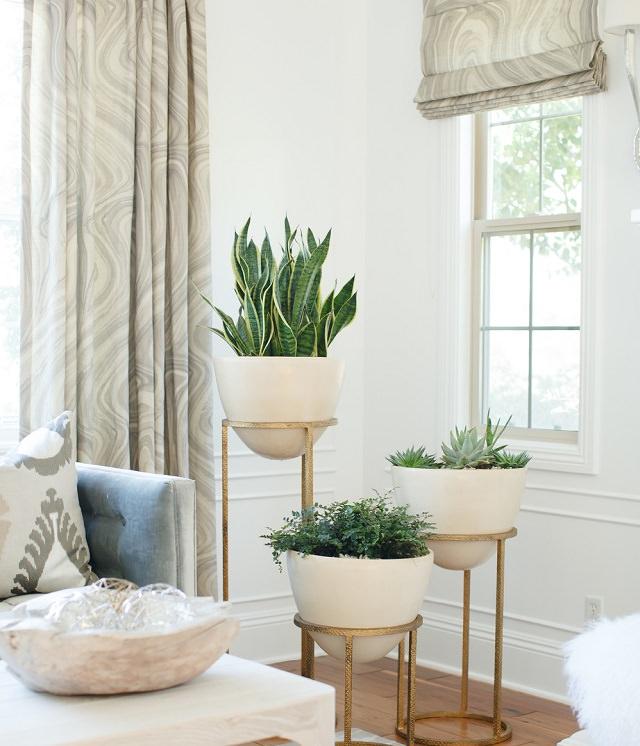
The snake plant is a low-maintenance succulent plant that thrives on neglect pretty well. If you have had little success with indoor gardening , do give the snake plant a try. All types of snake plant tolerate low light and prefer being potbound. The fact that it has thick and waxy leaves means it can withstand scarcity of water for prolonged periods of time. To put it simply, the snake plant is apt for lazy gardeners and two-week vacationers.
2. Tillandsia (Air Plants)
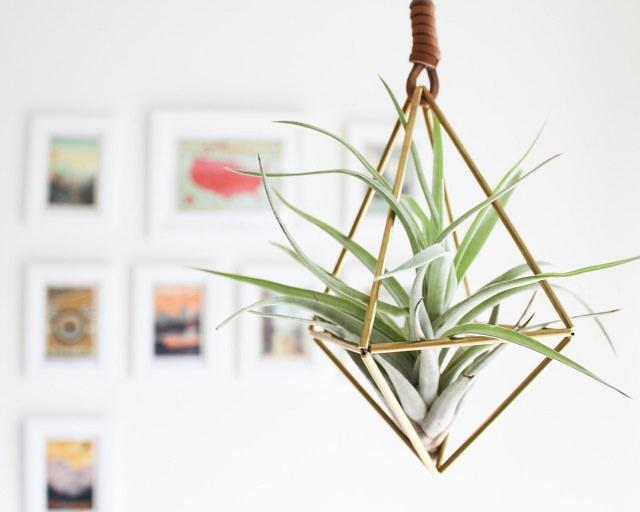
Tillandsia is a genus of air plants native to the deserts, forests and mountains of central and South America. Air plants are epiphyte, meaning they don’t need soil to grow. All you need is to mist or water them up once in a week. Some of the air plants also absorb dust– All this makes them interesting and low-maintenance houseplants. The air plants are a perfect choice for people who wish to add a touch of green to their home without much work.
3. Cast-Iron Plant

The cast-iron plant is true to its name- it’s literally indestructible. It can withstand extremes of conditions, including low light, low humidity, as well as a wide spectrum of temperatures. And it grows slowly, which means you don’t need to repot it often.
4. Kalanchoe

Kalanchoe is a genus of tropical succulent flowering plants, from the wide-leafed and bright ‘Flapjack’ to the compact Kalanchoe manginii or Kalanchoe blossfeldiana. Kalanchoes are easy to grow, all they ask for is a sunny spot and an occasional spritz of water. Both these varieties are architecturally interesting and last for so long with little attention from your end.
5. Philodendron

Philodendron is a fast-growing foliage houseplant with bottle-green heart-shaped leaves, similar to pothos. This plant is extremely durable and adapts well to low-light areas. Philodendron looks great in hanging baskets or when branches trailing down from above.
6. ZZ Plant
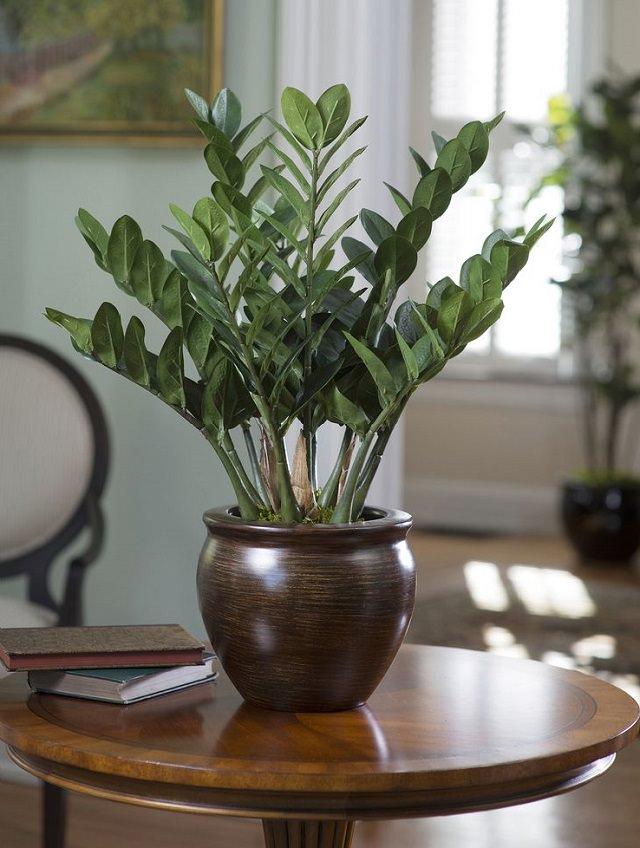
The ZZ plant is also known as the eternity plant as it lasts so long that it’s practically a challenge to kill it! Its fat succulent leaves are thick, fleshy leafstalks are so durable that they can be easily mistaken for plastic. Since the plant is a slow grower, you may want to purchase a large plant if in case you need a big specimen for your house.
7. Bromeliad
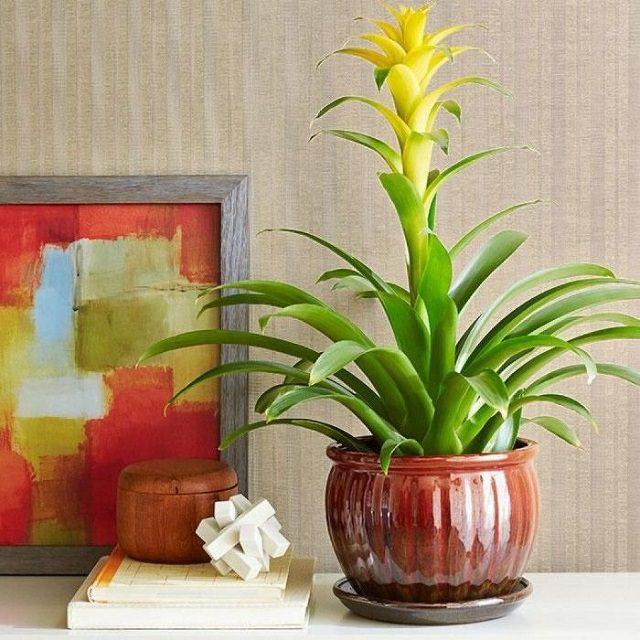
Bromeliad, like pineapple, belongs to the bromeliacea family. This plant produces a delicate pink inflorescence that is beautiful to look at. It lasts long too, and occasionally produces new side shoots that replace the original ones.
8. Jade Plant
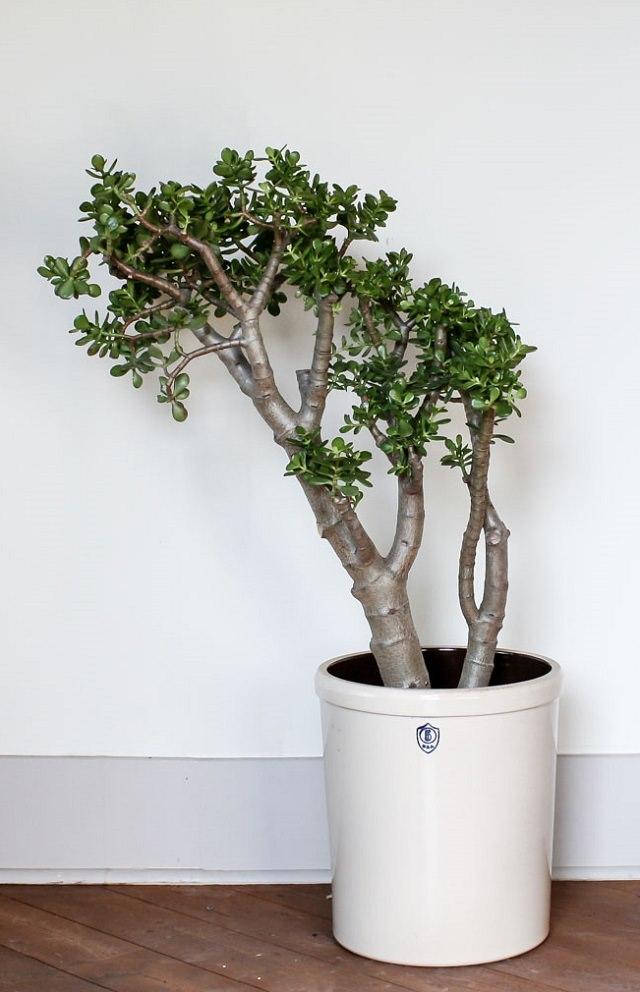
Native to South America, Jade is a low maintenance indoor plant. A succulent that retains water in its round, fleshy leaves. They thrive on neglect, so all you need to do is place them in a bright and airy spot and you’re done. As the thick trunk of jade plant easily gives it a mature look, it is also good for bonsai making.
Also Read: Best Plants and Trees for Bonsai
9. Succulents
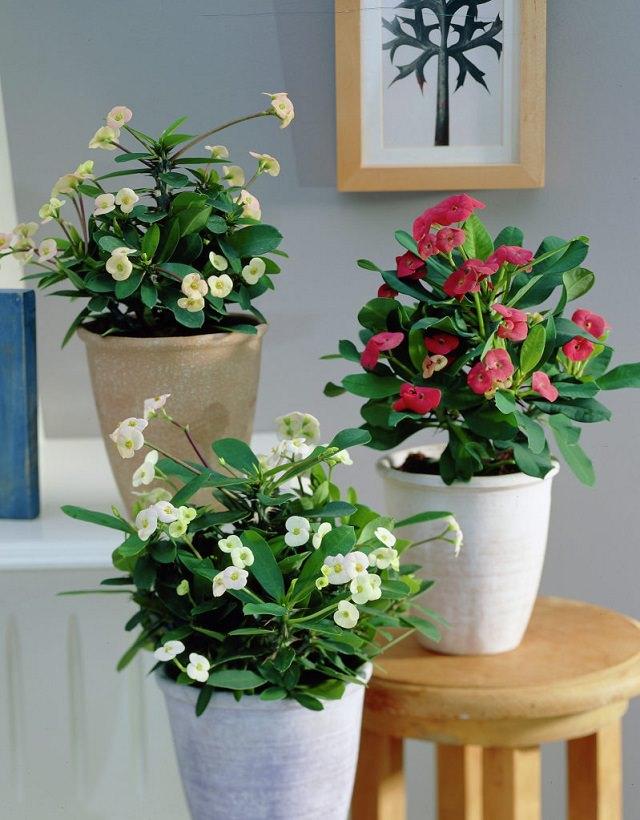
Whether its Crown of thorns or any other succulent most of them are the plants that are easy to grow indoors. Especially for those who forget to water the plants for days. If you’re interested in knowing more about the succulents that are easy to grow click here!
10. Pothos

Pothos is a fast-growing, leafy vine with striking variegated leaves that are tolerant to both irregular watering and low light conditions. The vine extends quickly, often leaving a 10-feet long, green trail over shelves or furniture. Though it’s not as drought-tolerant as many other plants in this list and demands some attention from you when it comes to watering.
11. Peace Lily

The peace lily is an easy-to-care houseplant that tolerates low light and low humidity really well and it seems like it is made for indoor conditions. Glossy, lance-shaped foliage with arched stems that surround the central flower spikes. It produces spoon-shaped blooms in summer usually but some varieties do blossom intermittently throughout the year. As an added bonus, it purifies noxious substances like formaldehyde and carbon monoxide from the air. If growing in a large pot peace lily can even go without water for a month. These plants thrive better on under-watering conditions.
12. Begonia
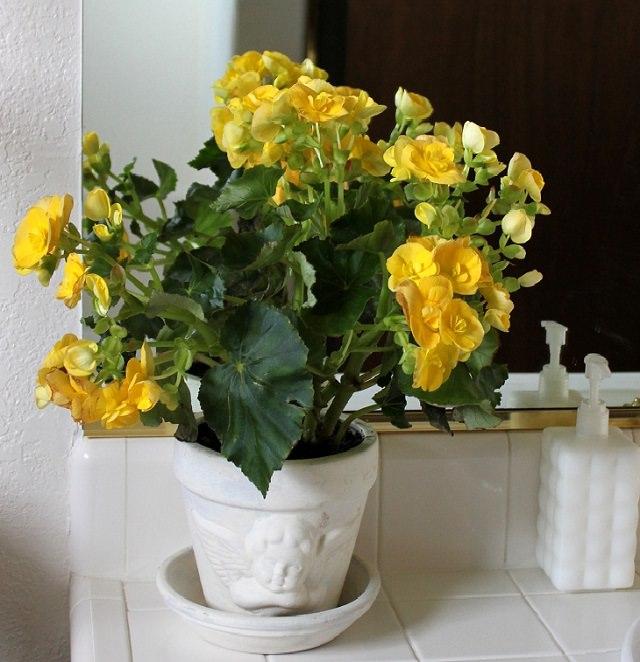
Begonias, with lush, green leaves and satiny flowers paint a pretty picture. Though they are more often thought of as outdoor plants, the fibrous and rhizomatous variants perform well indoors. They prefer humid environments, so you may want to water them 2-3 times a week in summer to make sure they stay healthy and green. They are not that fussy about light/temperature conditions. Bright, indirect sunlight works fine for them.
13. Aloe
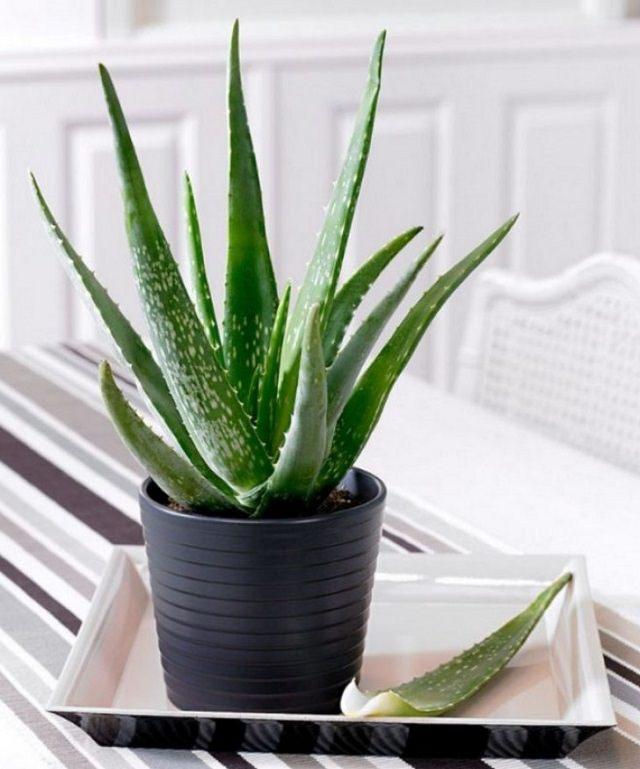
Especially, Aloe Vera is one of the most multi-purpose houseplants in Aloe genus you can choose for indoor gardening. Its plump, spiraling leaves ooze out a soothing gel that can be used for burns and cuts. You can use it to relieve sunburns and even ingest its gel for a minty, cool feeling. Aloe loves to have some direct light and a moderate spritz of water every week or two.
Also Read: How to Care for an Aloe Plant
14. Boston Fern
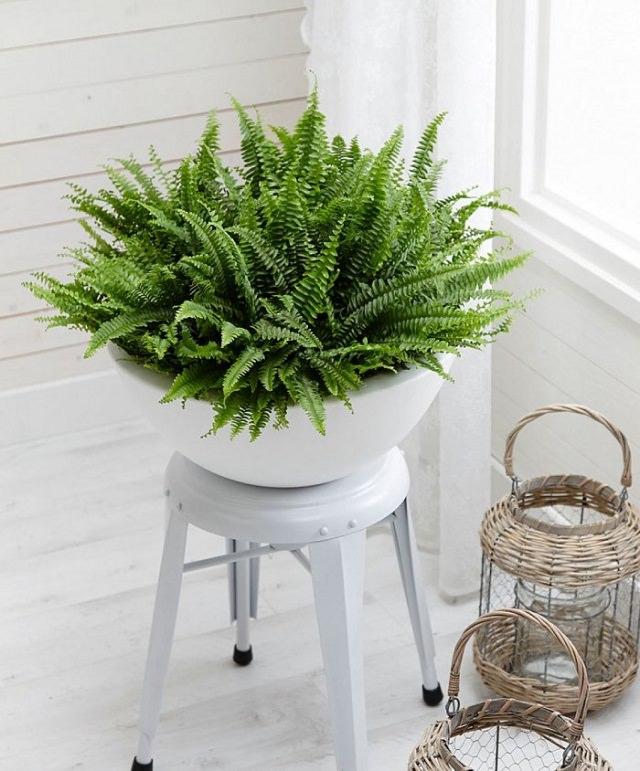
Renowned since the Victorian times, Boston fern is one of the most popular variants of fern. With its delicate, frilly leaves and lush, hanging fronds, it looks aesthetic when displayed in baskets hanging down from ceilings. Being the most drought-tolerant fern, it is easy to care for. All you have to do is to place it in a spot that gets indirect light, avoid dry air. Misting the plant in every few days also help by providing humidity.
15. Dracaena

The plants from Dracaena genus perform well as an indoor plant. They become great houseplants as they are tolerant to extreme indoor conditions. For instance, they survive well in under-watered soil. Additionally, they are not picky about light exposure. The young plants look great on tabletops, while the larger ones require sizable floor space improving the appearance of home and offices.
16. English Ivy

This plant is well known for its evergreen foliage. It is easy to maintain and needs as little as evenly moist soil and bright indirect light to grow well. The stems tend to grow long but can be easily controlled with pruning. For the best display, place your English ivy on a mantel where the stems can hang down luxuriantly.
17. Ponytail Palm

Contrary to its name, the ponytail palm isn’t a palm, in fact, it’s a succulent! AND; we love it. We listed it on our list of best succulents, easiest houseplants, and the best tall and large indoor plants. Don’t forget to check out these articles! It is a slow-growing plant, which means you don’t need to change the pot often. It performs best in sunny spots but never mind low lit areas receiving only bright indirect sunlight day long, also, the plant has low watering needs.
18. Spider Plant

Spider plant is one of the most grown low maintenance houseplants. This forgiving plant doesn’t mind irregular watering and goes for weeks without water if grown in cool indoor conditions. Keeping the spider plant in low light conditions without direct sunlight is also possible.
Also Read: Plants that Grow without Sunlight
19. Rubber Tree Plant
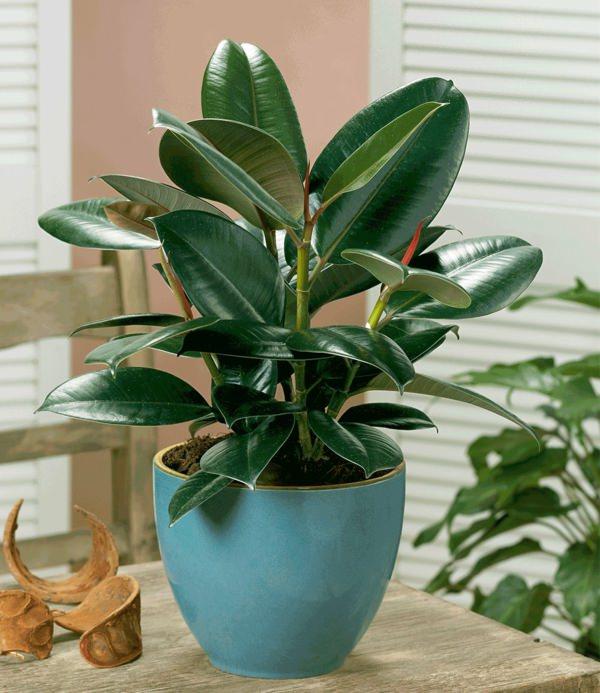
Rubber tree plant is an air purifying plant, it cleanses the formaldehyde. It is not difficult to grow and you can easily keep it in your home or office in a spot that is bright and receives a couple of hours of sunlight if possible. Avoid the exposure of the plant to the intense sun in afternoon.
There are plenty of good things about having plants in the house. For starters, they clean up the air and smell wonderful. Secondly, they add a much-needed dash of color and accentuate the appeal of your interior.
1. Snake Plant

The snake plant is a low-maintenance succulent plant that thrives on neglect pretty well. If you have had little success with indoor gardening , do give the snake plant a try. All types of snake plant tolerate low light and prefer being potbound. The fact that it has thick and waxy leaves means it can withstand scarcity of water for prolonged periods of time. To put it simply, the snake plant is apt for lazy gardeners and two-week vacationers.
2. Tillandsia (Air Plants)

Tillandsia is a genus of air plants native to the deserts, forests and mountains of central and South America. Air plants are epiphyte, meaning they don’t need soil to grow. All you need is to mist or water them up once in a week. Some of the air plants also absorb dust– All this makes them interesting and low-maintenance houseplants. The air plants are a perfect choice for people who wish to add a touch of green to their home without much work.
3. Cast-Iron Plant

The cast-iron plant is true to its name- it’s literally indestructible. It can withstand extremes of conditions, including low light, low humidity, as well as a wide spectrum of temperatures. And it grows slowly, which means you don’t need to repot it often.
4. Kalanchoe

Kalanchoe is a genus of tropical succulent flowering plants, from the wide-leafed and bright ‘Flapjack’ to the compact Kalanchoe manginii or Kalanchoe blossfeldiana. Kalanchoes are easy to grow, all they ask for is a sunny spot and an occasional spritz of water. Both these varieties are architecturally interesting and last for so long with little attention from your end.
5. Philodendron

Philodendron is a fast-growing foliage houseplant with bottle-green heart-shaped leaves, similar to pothos. This plant is extremely durable and adapts well to low-light areas. Philodendron looks great in hanging baskets or when branches trailing down from above.
6. ZZ Plant

The ZZ plant is also known as the eternity plant as it lasts so long that it’s practically a challenge to kill it! Its fat succulent leaves are thick, fleshy leafstalks are so durable that they can be easily mistaken for plastic. Since the plant is a slow grower, you may want to purchase a large plant if in case you need a big specimen for your house.
7. Bromeliad

Bromeliad, like pineapple, belongs to the bromeliacea family. This plant produces a delicate pink inflorescence that is beautiful to look at. It lasts long too, and occasionally produces new side shoots that replace the original ones.
8. Jade Plant

Native to South America, Jade is a low maintenance indoor plant. A succulent that retains water in its round, fleshy leaves. They thrive on neglect, so all you need to do is place them in a bright and airy spot and you’re done. As the thick trunk of jade plant easily gives it a mature look, it is also good for bonsai making.
Also Read: Best Plants and Trees for Bonsai
9. Succulents

Whether its Crown of thorns or any other succulent most of them are the plants that are easy to grow indoors. Especially for those who forget to water the plants for days. If you’re interested in knowing more about the succulents that are easy to grow click here!
10. Pothos

Pothos is a fast-growing, leafy vine with striking variegated leaves that are tolerant to both irregular watering and low light conditions. The vine extends quickly, often leaving a 10-feet long, green trail over shelves or furniture. Though it’s not as drought-tolerant as many other plants in this list and demands some attention from you when it comes to watering.
11. Peace Lily

The peace lily is an easy-to-care houseplant that tolerates low light and low humidity really well and it seems like it is made for indoor conditions. Glossy, lance-shaped foliage with arched stems that surround the central flower spikes. It produces spoon-shaped blooms in summer usually but some varieties do blossom intermittently throughout the year. As an added bonus, it purifies noxious substances like formaldehyde and carbon monoxide from the air. If growing in a large pot peace lily can even go without water for a month. These plants thrive better on under-watering conditions.
12. Begonia

Begonias, with lush, green leaves and satiny flowers paint a pretty picture. Though they are more often thought of as outdoor plants, the fibrous and rhizomatous variants perform well indoors. They prefer humid environments, so you may want to water them 2-3 times a week in summer to make sure they stay healthy and green. They are not that fussy about light/temperature conditions. Bright, indirect sunlight works fine for them.
13. Aloe

Especially, Aloe Vera is one of the most multi-purpose houseplants in Aloe genus you can choose for indoor gardening. Its plump, spiraling leaves ooze out a soothing gel that can be used for burns and cuts. You can use it to relieve sunburns and even ingest its gel for a minty, cool feeling. Aloe loves to have some direct light and a moderate spritz of water every week or two.
Also Read: How to Care for an Aloe Plant
14. Boston Fern

Renowned since the Victorian times, Boston fern is one of the most popular variants of fern. With its delicate, frilly leaves and lush, hanging fronds, it looks aesthetic when displayed in baskets hanging down from ceilings. Being the most drought-tolerant fern, it is easy to care for. All you have to do is to place it in a spot that gets indirect light, avoid dry air. Misting the plant in every few days also help by providing humidity.
15. Dracaena

The plants from Dracaena genus perform well as an indoor plant. They become great houseplants as they are tolerant to extreme indoor conditions. For instance, they survive well in under-watered soil. Additionally, they are not picky about light exposure. The young plants look great on tabletops, while the larger ones require sizable floor space improving the appearance of home and offices.
16. English Ivy

This plant is well known for its evergreen foliage. It is easy to maintain and needs as little as evenly moist soil and bright indirect light to grow well. The stems tend to grow long but can be easily controlled with pruning. For the best display, place your English ivy on a mantel where the stems can hang down luxuriantly.
17. Ponytail Palm

Contrary to its name, the ponytail palm isn’t a palm, in fact, it’s a succulent! AND; we love it. We listed it on our list of best succulents, easiest houseplants, and the best tall and large indoor plants. Don’t forget to check out these articles! It is a slow-growing plant, which means you don’t need to change the pot often. It performs best in sunny spots but never mind low lit areas receiving only bright indirect sunlight day long, also, the plant has low watering needs.
18. Spider Plant

Spider plant is one of the most grown low maintenance houseplants. This forgiving plant doesn’t mind irregular watering and goes for weeks without water if grown in cool indoor conditions. Keeping the spider plant in low light conditions without direct sunlight is also possible.
Also Read: Plants that Grow without Sunlight
19. Rubber Tree Plant

Rubber tree plant is an air purifying plant, it cleanses the formaldehyde. It is not difficult to grow and you can easily keep it in your home or office in a spot that is bright and receives a couple of hours of sunlight if possible. Avoid the exposure of the plant to the intense sun in afternoon.
2
1
文章
扭扭
2017年05月23日

Growing strawberries in gutters is the best way to use up your vertical space smartly. Strawberries are super easy fruits to grow in gutters, it also saves them from diseases like crown rot and fruit rot.
You can try to grow strawberries upside down too, learn here.
Things You’ll Need for Growing Strawberries in Gutters
A simple PVC pipe with a diameter of 10 cm., hole saw to make holes. You will also need something to clog pipe from both sides.
1. Step One
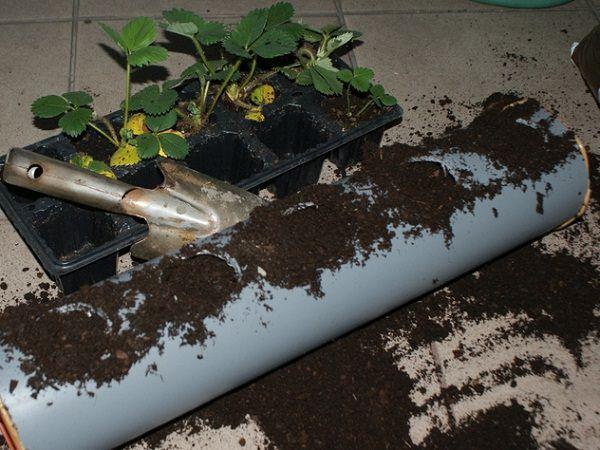
Image Credit: ogrodwcentrum
Divide PVC pipes into equal sizes as many you want and make holes according to the size of pipe (approx. 5 cm). Use hole saw to make holes. You’ll also need to make a few hole for drainage on the bottom. Then clog pipe from both sides.
2. Step Two

Image Credit: ogrodwcentrum
Now fill up the soil in the holes you made and plant strawberry plants carefully in each hole. Take care that the crown of strawberry plants should not be covered in soil.
3. Step Three

You can try to grow strawberries upside down too, learn here.
Things You’ll Need for Growing Strawberries in Gutters
A simple PVC pipe with a diameter of 10 cm., hole saw to make holes. You will also need something to clog pipe from both sides.
1. Step One

Image Credit: ogrodwcentrum
Divide PVC pipes into equal sizes as many you want and make holes according to the size of pipe (approx. 5 cm). Use hole saw to make holes. You’ll also need to make a few hole for drainage on the bottom. Then clog pipe from both sides.
2. Step Two

Image Credit: ogrodwcentrum
Now fill up the soil in the holes you made and plant strawberry plants carefully in each hole. Take care that the crown of strawberry plants should not be covered in soil.
3. Step Three

1
0
文章
lenny
2017年05月23日

Growing lettuce in containers is fun and easy and you can harvest fresh, crispy, and organic lettuce leaves for your salads in no time.

Lettuce is one of the vegetables that is very easy to grow in pots and you can even grow it in a small container. Healthy and continuously productive, this crispy salad green has many qualities that make it a blessing for health. Rich in water, fiber, vitamins and minerals such as calcium, magnesium, potassium and sodium, the lettuce is perfect for those who have intestinal transit problems, and also contributes to the smooth functioning of the nervous system.
You can start to harvest lettuce in no time– about 8 weeks for most of the varieties, it is super easy to grow and productive; similar to spinach. And the best part is you don’t need a lot of space to grow lettuce.
Also Read: How to Grow Spinach
Choosing a Pot
Almost all the lettuce varieties grow well in pots. As their shallow roots don’t need deep soil, they do best in wide and shallow containers. The pot must have adequate drainage holes in the bottom and should be at least 6 inches deep. You can use any material for pots such as plastic, clay or terracotta pots.
*However, if you’re growing lettuce in a container in a warm climate, do that in clay pots and plant heat resistant varieties.Planting Lettuce in Pots

Lettuce is a cool season crop and growing lettuce in pots is possible from spring to fall in most of the regions. Although, if you live in USDA Zones 10-11 or in any other subtropical or tropical part of the world, you should try to grow lettuce in winter.
You can easily cultivate the lettuce from seeds or from seedlings. If you want to grow it from seeds, read this post. Alternatively, you can directly buy the seedlings from a nearby nursery.
For continuous harvest do successive planting, sow seeds in every two weeks throughout the growing season.
In summer, when the weather starts to heat up the lettuce tends to bolt, to reduce this tendency keep your potted lettuce plant in a cool spot and provide proper shade.
Requirements for Growing Lettuce in ContainersSpacing
Considering you’re growing lettuce in a small space in your container garden, we assume you’ll harvest your lettuce plants regularly; trying “Cut And Come Again” method. This way you don’t need to care much about spacing.
Sow seeds densely and thin out the seedlings as they grow picking young, tender leaves regularly. Keep the plants 4-6 inches apart (depending on the size of the leaves you want and cultivar). However, head lettuces require more spacing than leaf lettuces and planting depth (8 inches) must be increased too.
Position
The lettuce loves the sunlight (*more in cooler zones) though it can be grown easily in a partially shaded area but if you’re growing lettuce in a warm climate where the sun is intense try to place the pot in a spot that receives only a few hours of morning sun.
During the hottest hours of the day (in the afternoon) it is recommended to create a shade for the plant to prevent the drying of the soil as lettuce prefers slightly moist soil constantly. Also, move the container in a cool spot when the temperature rises as this favorite green is heat sensitive.
Soil
For growing healthy lettuce, use a good quality soil mix which has plenty of organic matter, such as compost and peat. You can also add well-rotted manure or compost additionally. The soil you use must be loamy and well-drained and doesn’t hold water too much.
Watering
In shallow pots, you may need to water frequently so that the plant will not dry out completely. Make sure that you not only keep the soil slightly moist but also avoid to overwater your container grown lettuces as overwatering can kill the plants due to root rot.
Fertilizer
Because lettuce plants mature quickly, a single or double application of fertilizer is usually all that is needed to boost the production. Before you fertilize, wait for a few weeks to allow the seedlings to establish. To fertilize lettuce you can use a granular balanced fertilizer such as 10-10-10. You can also use liquid fertilizer for a quick boost. When fertilizing, be sure to follow manufacturer’s instructions as both over and under fertilization can be harmful.
Pests and Diseases
Growing lettuces in containers require care from leaf eating insects. However, if the plants are healthy there are fewer chances of infestation of pests or diseases. Mildew, leaf spot, rot and a variety of bacterial infections are common diseases that can attack lettuce. In pests and insects– caterpillars, cutworms, aphids, maggots and beetles can cause damage to the plant.
Harvesting
Once the lettuce leaves have reached the height of 4-6″ (the baby green size perfect for cut and come again method) or according to your desired size, either pick the outer leaves individually or harvest them by cutting the leaves off 1″ (2-3 cm) from above the base or crown (Must remember, don’t cut into or below the crown or else your plant will die). This way the plant will grow back and you’ll be able to harvest it again.
You can also pick the leaf lettuce before maturity, it’s simple, just remove the outer leaves when you need them in salads and keep the center leaves growing.

Lettuce is one of the vegetables that is very easy to grow in pots and you can even grow it in a small container. Healthy and continuously productive, this crispy salad green has many qualities that make it a blessing for health. Rich in water, fiber, vitamins and minerals such as calcium, magnesium, potassium and sodium, the lettuce is perfect for those who have intestinal transit problems, and also contributes to the smooth functioning of the nervous system.
You can start to harvest lettuce in no time– about 8 weeks for most of the varieties, it is super easy to grow and productive; similar to spinach. And the best part is you don’t need a lot of space to grow lettuce.
Also Read: How to Grow Spinach
Choosing a Pot
Almost all the lettuce varieties grow well in pots. As their shallow roots don’t need deep soil, they do best in wide and shallow containers. The pot must have adequate drainage holes in the bottom and should be at least 6 inches deep. You can use any material for pots such as plastic, clay or terracotta pots.
*However, if you’re growing lettuce in a container in a warm climate, do that in clay pots and plant heat resistant varieties.Planting Lettuce in Pots

Lettuce is a cool season crop and growing lettuce in pots is possible from spring to fall in most of the regions. Although, if you live in USDA Zones 10-11 or in any other subtropical or tropical part of the world, you should try to grow lettuce in winter.
You can easily cultivate the lettuce from seeds or from seedlings. If you want to grow it from seeds, read this post. Alternatively, you can directly buy the seedlings from a nearby nursery.
For continuous harvest do successive planting, sow seeds in every two weeks throughout the growing season.
In summer, when the weather starts to heat up the lettuce tends to bolt, to reduce this tendency keep your potted lettuce plant in a cool spot and provide proper shade.
Requirements for Growing Lettuce in ContainersSpacing
Considering you’re growing lettuce in a small space in your container garden, we assume you’ll harvest your lettuce plants regularly; trying “Cut And Come Again” method. This way you don’t need to care much about spacing.
Sow seeds densely and thin out the seedlings as they grow picking young, tender leaves regularly. Keep the plants 4-6 inches apart (depending on the size of the leaves you want and cultivar). However, head lettuces require more spacing than leaf lettuces and planting depth (8 inches) must be increased too.
Position
The lettuce loves the sunlight (*more in cooler zones) though it can be grown easily in a partially shaded area but if you’re growing lettuce in a warm climate where the sun is intense try to place the pot in a spot that receives only a few hours of morning sun.
During the hottest hours of the day (in the afternoon) it is recommended to create a shade for the plant to prevent the drying of the soil as lettuce prefers slightly moist soil constantly. Also, move the container in a cool spot when the temperature rises as this favorite green is heat sensitive.
Soil
For growing healthy lettuce, use a good quality soil mix which has plenty of organic matter, such as compost and peat. You can also add well-rotted manure or compost additionally. The soil you use must be loamy and well-drained and doesn’t hold water too much.
Watering
In shallow pots, you may need to water frequently so that the plant will not dry out completely. Make sure that you not only keep the soil slightly moist but also avoid to overwater your container grown lettuces as overwatering can kill the plants due to root rot.
Fertilizer

Because lettuce plants mature quickly, a single or double application of fertilizer is usually all that is needed to boost the production. Before you fertilize, wait for a few weeks to allow the seedlings to establish. To fertilize lettuce you can use a granular balanced fertilizer such as 10-10-10. You can also use liquid fertilizer for a quick boost. When fertilizing, be sure to follow manufacturer’s instructions as both over and under fertilization can be harmful.
Pests and Diseases
Growing lettuces in containers require care from leaf eating insects. However, if the plants are healthy there are fewer chances of infestation of pests or diseases. Mildew, leaf spot, rot and a variety of bacterial infections are common diseases that can attack lettuce. In pests and insects– caterpillars, cutworms, aphids, maggots and beetles can cause damage to the plant.
Harvesting
Once the lettuce leaves have reached the height of 4-6″ (the baby green size perfect for cut and come again method) or according to your desired size, either pick the outer leaves individually or harvest them by cutting the leaves off 1″ (2-3 cm) from above the base or crown (Must remember, don’t cut into or below the crown or else your plant will die). This way the plant will grow back and you’ll be able to harvest it again.
You can also pick the leaf lettuce before maturity, it’s simple, just remove the outer leaves when you need them in salads and keep the center leaves growing.
0
0
文章
Colorful
2017年05月23日

Love growing plants indoors? Some of the best indoor vines and climbers that are easy to grow are listed here. Must check out!A house with indoor plants looks more lavish and expensive. That’s a fact!1. Heartleaf Philodendron
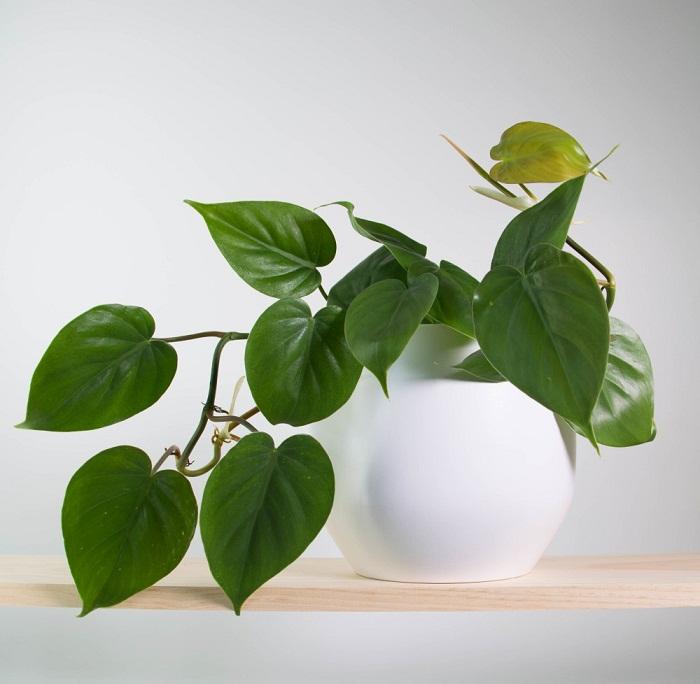
Heartleaf Philodendron is extremely easy to grow and great for beginners. It needs a moderate amount of light and prefers the soil to dry out between watering spells.
Also Read: Easiest Indoor Plants
2. Ivy
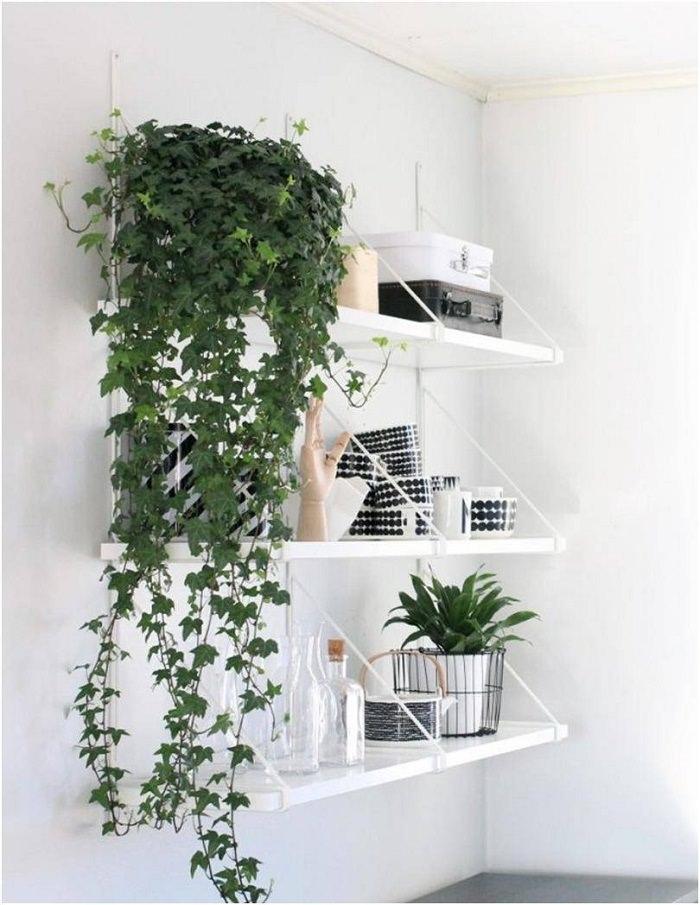
Ivy is one of the best indoor vines. It can easily adapt to many light conditions. This fast-growing vine has evergreen foliage that remains green even in winters. Plant it in a container that is wide and shallow rather than narrow and deep. Keep the pot in a spot that receives bright indirect sun.
Also Read: Best Indoor Plants According to Different Light Conditions
3. Pothos
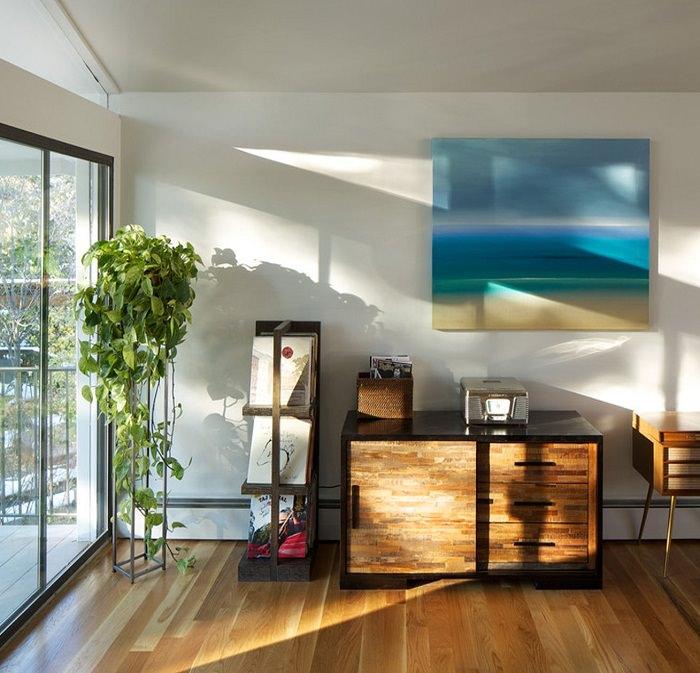
Plants of the pothos family are easiest to grow and most of them can even grow without direct sunlight. They become great houseplants for beginners. Attractive and hardy vine prefers bright indirect light and a draft free place. It can grow in low light and needs moist soil.
Also Read: Plants You can Grow Without Sunlight
4. Betel Leaf Plant

Betel leaf plant is very popular in South and East Asia, especially in the Indian subcontinent, Indonesia, Vietnam, and Thailand. This vine from pepper family has many culinary and medicinal uses. It can be tried indoors if space where you want to keep it receives part sun and remains slightly humid. All the other information is available here.
5. Jasmine

Many jasmine varieties can be grown indoors. If you keep this most fragrant vine in a bright spot where it receives some hours of direct sunlight daily, it’ll grow. The selection of jasmine varieties you want to plant indoors depends on the climate you live in. For colder regions, Jasminum polyanthum is the one you can try, whereas in tropics most of the plants from this species will grow.
6. Creeping Fig

It’s a slow growing creeper with small, leathery dark green foliage. Vigorous-growing, clinging, dense branches adhere to any surface and look enchanting. Be careful not to overwater creeping fig. Let the soil dry out before watering.
7. Arrowhead Plant

This elegant vine like houseplant prefers to be in a spot that is bright, needs moderate watering. Allow the soil to dry out between watering spells and make sure not to overwater it, as it may lead to root rot.
Also Read: Houseplants that are Harmful to Dogs
8. Hoya (Hoya spp.)
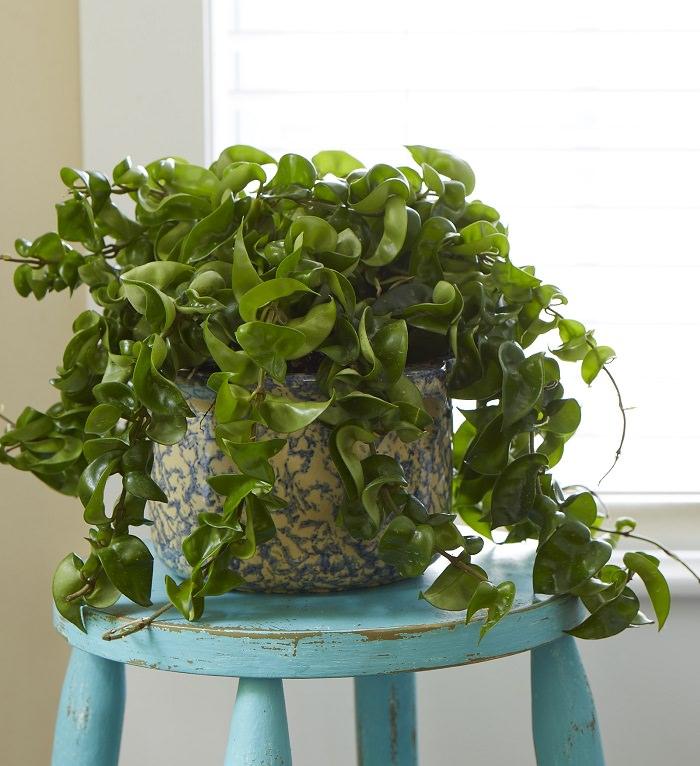
Beautiful waxy foliage and fragrant flowers, hoya looks stunning when grown indoors. The plant has low watering needs and doesn’t mind if you forget to water it occasionally. The trailing stems of this plant is approximately a foot in length along with clusters of aromatic waxy flowers.
Also Read: 99 Great Ideas to Display Houseplants
9. String Of Pearls
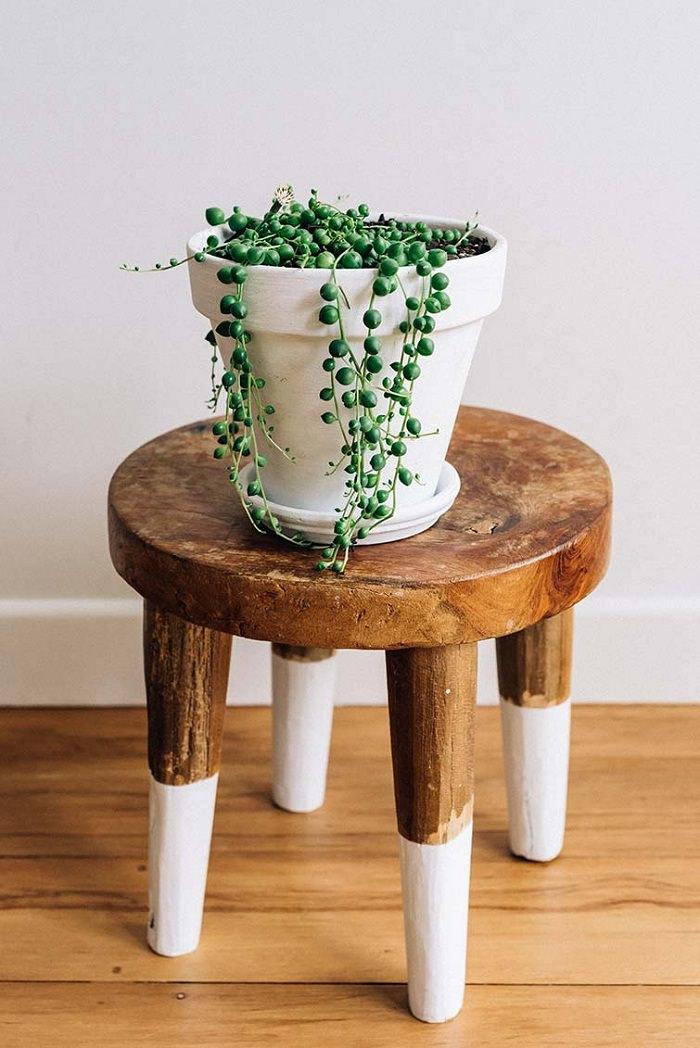
Growing string of pearls is easy, it is a low-maintenance creeper. This succulent tolerates prolonged drought and does well in a bright light position. You can also combine it with other houseplants to create a great appearance or it can be grown in a hanging basket.
10. Black Eyed Susan Vine

Black-eyed Susan vine can be grown indoors. Depending on your climate, this annual or perennial flowering plant can add a dramatic appeal to your rooms. Keep it near a window, where it receives a lot of sun.
11. Inch Plant
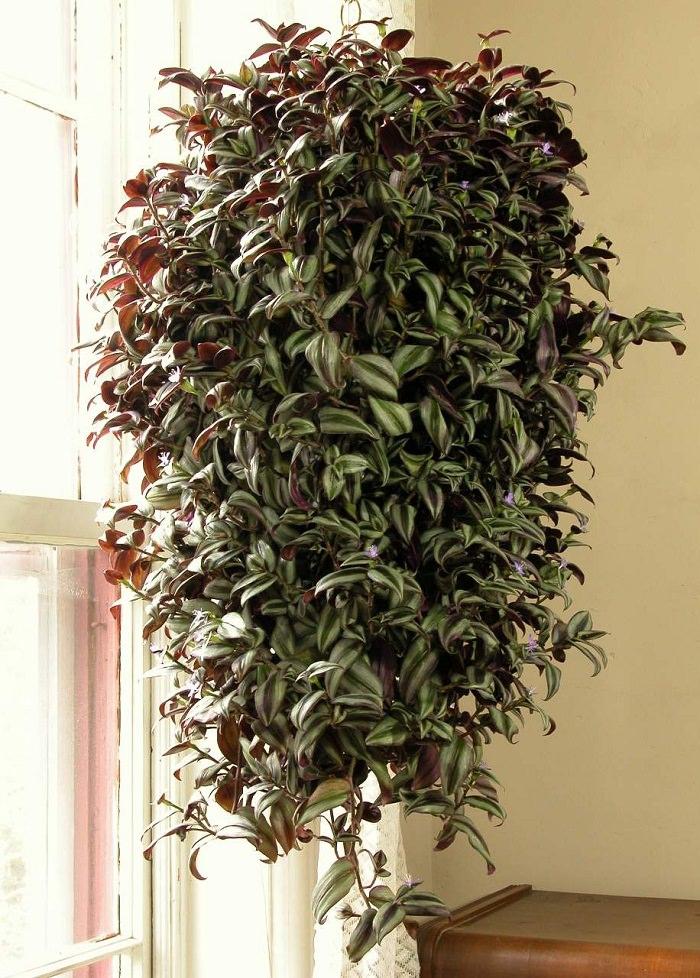
Also called “Wandering Jew” or “Purple heart”, this wonderful houseplant has beautiful trailing stems with attractive zebra patterned foliage that look stunning. Grow it in a pot or hanging basket, it’ll thrive. You can also keep this plant in dim light, but the markings on the foliage will fade.

Heartleaf Philodendron is extremely easy to grow and great for beginners. It needs a moderate amount of light and prefers the soil to dry out between watering spells.
Also Read: Easiest Indoor Plants
2. Ivy

Ivy is one of the best indoor vines. It can easily adapt to many light conditions. This fast-growing vine has evergreen foliage that remains green even in winters. Plant it in a container that is wide and shallow rather than narrow and deep. Keep the pot in a spot that receives bright indirect sun.
Also Read: Best Indoor Plants According to Different Light Conditions
3. Pothos

Plants of the pothos family are easiest to grow and most of them can even grow without direct sunlight. They become great houseplants for beginners. Attractive and hardy vine prefers bright indirect light and a draft free place. It can grow in low light and needs moist soil.
Also Read: Plants You can Grow Without Sunlight
4. Betel Leaf Plant

Betel leaf plant is very popular in South and East Asia, especially in the Indian subcontinent, Indonesia, Vietnam, and Thailand. This vine from pepper family has many culinary and medicinal uses. It can be tried indoors if space where you want to keep it receives part sun and remains slightly humid. All the other information is available here.
5. Jasmine

Many jasmine varieties can be grown indoors. If you keep this most fragrant vine in a bright spot where it receives some hours of direct sunlight daily, it’ll grow. The selection of jasmine varieties you want to plant indoors depends on the climate you live in. For colder regions, Jasminum polyanthum is the one you can try, whereas in tropics most of the plants from this species will grow.
6. Creeping Fig

It’s a slow growing creeper with small, leathery dark green foliage. Vigorous-growing, clinging, dense branches adhere to any surface and look enchanting. Be careful not to overwater creeping fig. Let the soil dry out before watering.
7. Arrowhead Plant

This elegant vine like houseplant prefers to be in a spot that is bright, needs moderate watering. Allow the soil to dry out between watering spells and make sure not to overwater it, as it may lead to root rot.
Also Read: Houseplants that are Harmful to Dogs
8. Hoya (Hoya spp.)

Beautiful waxy foliage and fragrant flowers, hoya looks stunning when grown indoors. The plant has low watering needs and doesn’t mind if you forget to water it occasionally. The trailing stems of this plant is approximately a foot in length along with clusters of aromatic waxy flowers.
Also Read: 99 Great Ideas to Display Houseplants
9. String Of Pearls

Growing string of pearls is easy, it is a low-maintenance creeper. This succulent tolerates prolonged drought and does well in a bright light position. You can also combine it with other houseplants to create a great appearance or it can be grown in a hanging basket.
10. Black Eyed Susan Vine

Black-eyed Susan vine can be grown indoors. Depending on your climate, this annual or perennial flowering plant can add a dramatic appeal to your rooms. Keep it near a window, where it receives a lot of sun.
11. Inch Plant

Also called “Wandering Jew” or “Purple heart”, this wonderful houseplant has beautiful trailing stems with attractive zebra patterned foliage that look stunning. Grow it in a pot or hanging basket, it’ll thrive. You can also keep this plant in dim light, but the markings on the foliage will fade.
4
4
文章
安静的美女子
2017年05月23日

Pachira Aquatica care and growing is easy. Also known as “Money Tree” it can easily be multiplied and is not threatened by many pests and diseases.
USDA Zones— Can be grown in all the zones as houseplant
Difficulty— Easy
Other Names— Malabar chestnut, French Peanut, Guiana chestnut, Provision tree, Saba nut, Monguba, Pumpo, Money tree, Money plant
Propagation
If you can’t find a potted money tree at the nursery. Growing money tree from seeds and cuttings is possible. However, money tree grown from seed grows slowly so it is better to propagate Pachira Aquatica from cuttings.
Requirements for Growing Pachira Money TreeLocation
The Money Tree likes a bright and warm location. If growing money tree indoors, you need to keep it near a bright window where it receives indirect light.
In addition, the houseplant must be sheltered from drafts.
Temperature
Keep the plant at moderate room temperature. Try not to expose it to the temperature below 50 F (10 C) for a long time as this tropical plant is not cold hardy. However, it can bear slight freezing temperatures down to 28 F for a short period.
Soil
Growing Pachira Aquatica needs a well-drained, loose and nutrient-rich soil.
Watering
The Money tree requires moderate watering. Keep the soil slightly moist but too much water is absolutely dangerous and causes the death of Pachira Aquatica. It is better to water the plant deeply but infrequently, only when the top surface of soil dries out.
Sprinkle the plant to increase humidity level if possible, as the plant likes high humidity. For spraying, use lime-free water. Otherwise, limescale will form on the leaves and make it look less attractive.
Pachira Aquatica CareFertilizing
Do not fertilize during the first year of planting. Fertilize the plant with liquid houseplant fertilizer but only in the growing season in every 14 days or so.
Pruning Pachira Aquatica
Pruning Pachira Aquatica is not necessary. Prune it if you want to give it a certain shape or control its height.
Repotting
Potted money tree plant usually comes in a small pot. Therefore, it is recommended that you must repot it immediately after the purchase. Repotting after every 2-3 years is usually required.
Overwintering
Pachira Aquatica care in winter is important. Overwinter it at room temperature. This should not be under 50 F (10 C), at least not for a long time.
Supply sufficiently light and humidity. Pour very little water in winter as the plant stops growing due to the temperature drop.
Pests and Diseases

USDA Zones— Can be grown in all the zones as houseplant
Difficulty— Easy
Other Names— Malabar chestnut, French Peanut, Guiana chestnut, Provision tree, Saba nut, Monguba, Pumpo, Money tree, Money plant
Propagation
If you can’t find a potted money tree at the nursery. Growing money tree from seeds and cuttings is possible. However, money tree grown from seed grows slowly so it is better to propagate Pachira Aquatica from cuttings.
Requirements for Growing Pachira Money TreeLocation
The Money Tree likes a bright and warm location. If growing money tree indoors, you need to keep it near a bright window where it receives indirect light.
In addition, the houseplant must be sheltered from drafts.
Temperature
Keep the plant at moderate room temperature. Try not to expose it to the temperature below 50 F (10 C) for a long time as this tropical plant is not cold hardy. However, it can bear slight freezing temperatures down to 28 F for a short period.
Soil
Growing Pachira Aquatica needs a well-drained, loose and nutrient-rich soil.
Watering
The Money tree requires moderate watering. Keep the soil slightly moist but too much water is absolutely dangerous and causes the death of Pachira Aquatica. It is better to water the plant deeply but infrequently, only when the top surface of soil dries out.
Sprinkle the plant to increase humidity level if possible, as the plant likes high humidity. For spraying, use lime-free water. Otherwise, limescale will form on the leaves and make it look less attractive.
Pachira Aquatica CareFertilizing
Do not fertilize during the first year of planting. Fertilize the plant with liquid houseplant fertilizer but only in the growing season in every 14 days or so.
Pruning Pachira Aquatica
Pruning Pachira Aquatica is not necessary. Prune it if you want to give it a certain shape or control its height.
Repotting
Potted money tree plant usually comes in a small pot. Therefore, it is recommended that you must repot it immediately after the purchase. Repotting after every 2-3 years is usually required.
Overwintering
Pachira Aquatica care in winter is important. Overwinter it at room temperature. This should not be under 50 F (10 C), at least not for a long time.
Supply sufficiently light and humidity. Pour very little water in winter as the plant stops growing due to the temperature drop.
Pests and Diseases
0
0
文章
安静的美女子
2017年05月23日

Learn how to grow geranium indoors, growing geranium as a houseplant will allow you to have them year round. Check out!

Love geraniums? That’s good! Now you might be asking– Is it possible to grow geraniums indoors? Definitely yes, although growing geranium indoors is not as easy as other houseplants. There are some basic key requirements and geranium care information you need to know.
As you know geraniums (Pelargonium) are not winter hardy in cold climate, the best way to grow them year-round is to grow them indoors.Choosing a type of geranium you want to grow
Choose healthy geranium plants from a nearby nursery. Look out for your favorite flower colors and scents. Also, remember some of the geranium cultivars never bloom and grown for their fragrant leaves only. Mother Earth Living has good information on geranium varieties you can grow indoors.
Requirements for Growing Geranium Indoors

Location
Geraniums love the sun and don’t mind drenching in sunlight for long hours. Therefore, if your room has a South or West facing window, place them there.
Even when grown indoors geranium requires exposure to direct sun in order to thrive and bloom.
If you can’t keep the geranium near a sunny window use 40-watt supplemental fluorescent tube lighting fixed 12 inches over the plants for minimum 14 hours each day to help them growing.Soil
Don’t forget, the right soil is the key! Avoid soil that blocks the drainage holes. Use soilless potting mix. Don’t use garden soil, the texture of soil should be well-drained and loamy.
Watering
Here comes the most important part, proper watering ensures whether your geranium plant will live or die. As we know geranium is a drought-tolerant plant, it doesn’t require regular watering. Water only when the soil seems dry. Avoid overwatering!
Temperature
Avoid placing your geranium plants in cold, hot or drafty spots. Geranium adjusts well to room temperature if it is warm. However, during the day the temperature around 65 to 70 F and around 55 F at night are optimum.
Indoor Geranium Plant Care

Fertilizer
During the growing season fertilize every month using half strength all purpose liquid fertilizer for optimum growth. Instead, you can use slow release fertilizer as well.
Pinching and Pruning
To have a bushy, well-branched indoor geranium plant, remove the tips occasionally. Also, you can prune or cut the stems to get the desired shape.
Overwintering
As geraniums are not winter hardy it is important that you keep them away from drafts and too much cold. Also, watering must be reduced too!
Pests and Diseases
Overwatering can cause root rot, wetting the leaves while watering leads to fungal infection. In pests, mites, mealybugs, and aphids can be a problem.

Love geraniums? That’s good! Now you might be asking– Is it possible to grow geraniums indoors? Definitely yes, although growing geranium indoors is not as easy as other houseplants. There are some basic key requirements and geranium care information you need to know.
As you know geraniums (Pelargonium) are not winter hardy in cold climate, the best way to grow them year-round is to grow them indoors.Choosing a type of geranium you want to grow
Choose healthy geranium plants from a nearby nursery. Look out for your favorite flower colors and scents. Also, remember some of the geranium cultivars never bloom and grown for their fragrant leaves only. Mother Earth Living has good information on geranium varieties you can grow indoors.
Requirements for Growing Geranium Indoors

Location
Geraniums love the sun and don’t mind drenching in sunlight for long hours. Therefore, if your room has a South or West facing window, place them there.
Even when grown indoors geranium requires exposure to direct sun in order to thrive and bloom.
If you can’t keep the geranium near a sunny window use 40-watt supplemental fluorescent tube lighting fixed 12 inches over the plants for minimum 14 hours each day to help them growing.Soil
Don’t forget, the right soil is the key! Avoid soil that blocks the drainage holes. Use soilless potting mix. Don’t use garden soil, the texture of soil should be well-drained and loamy.
Watering
Here comes the most important part, proper watering ensures whether your geranium plant will live or die. As we know geranium is a drought-tolerant plant, it doesn’t require regular watering. Water only when the soil seems dry. Avoid overwatering!
Temperature
Avoid placing your geranium plants in cold, hot or drafty spots. Geranium adjusts well to room temperature if it is warm. However, during the day the temperature around 65 to 70 F and around 55 F at night are optimum.
Indoor Geranium Plant Care

Fertilizer
During the growing season fertilize every month using half strength all purpose liquid fertilizer for optimum growth. Instead, you can use slow release fertilizer as well.
Pinching and Pruning
To have a bushy, well-branched indoor geranium plant, remove the tips occasionally. Also, you can prune or cut the stems to get the desired shape.
Overwintering
As geraniums are not winter hardy it is important that you keep them away from drafts and too much cold. Also, watering must be reduced too!
Pests and Diseases
Overwatering can cause root rot, wetting the leaves while watering leads to fungal infection. In pests, mites, mealybugs, and aphids can be a problem.
3
3
Judikay:Also, should I change the soil in the baskets in the winter?
Judikay:I grow geraniums indoors every year in hanging baskets but I never got the nice & bushy. I also just brought in Martha Washington & they are very leggy. I don’t know how to pinch them back. They are getting so leggy,, they break. Then, I don’t know how to start the branches.
文章
安静的美女子
2017年05月23日

Find out how to grow and care for fiddle leaf fig. Learn about the right growing requirements and fiddle leaf fig care below.

Image Credit: Thebrunetteone.com
USDA Zones— 10 – 11, *can be grown indoors in cooler zones
Difficulty— Easy
Scientific Name— Ficus lyrata
Placing a little piece of nature inside the house or apartment does not necessarily mean it will be difficult to maintain. Many plants that offer a beautiful and elegant look in the house are also easy to grow, such as fiddle leaf fig (ficus lyrata). Fiddle Leaf Fig is well suited for growing indoors because it does not become excessively large and at the same time remain noticeable. Fiddle leaf fig care and growing is simple if you fulfill a few basic requirements, which are given below.
Fiddle Leaf Fig Care Information
Fiddle leaf is native to tropics and on its origin place, it grows tall (up to 40 feet), but its size can easily be reduced and kept under control (under 2 m) when grown in pots as a houseplant. Fiddle leaf fig’s leaves are large and dark in color– glossy and leathery, furrowed with yellow veins.
The plant with proper pruning, grows so dense, creating a web of leaves that look elegant and can change the appearance of any room, able to aesthetically fit in any type of environment. It also produces fruit but they are not edible and difficult to develop indoors.
How to Grow Fiddle Leaf Fig TreePropagation
Propagation is usually done from cuttings in the spring. Growing fiddle leaf fig from cuttings is easy, if not available, you can buy a potted plant from nursery and multiply it.
Location
Fiddle leaf fig as a houseplant, grows in a well lit spot. Where it receives indirect sunlight all day long. It likes warm temperature approx. 60 – 70 F (15 – 20 C). When growing fiddle leaf fig, remember that it prefers moist, humid air. Homes are rather dry, so alternatively you can mist the plant often to increase the humidity level.
Requirements for Growing Fiddle Leaf Fig IndoorsSoil
Soil is an essential ingredient in the growth of healthy plant. Loose, well drained soil that is rich in nutrients and organic matter is required.
Watering
Keep the soil slightly moist but let the top 1 inch surface to dry out between watering spells. In the summer it requires frequent watering. In winter, reduce the watering to avoid root rot.
Fiddle Leaf Fig Care

Image Credit: Room for Tuesday
Fiddle leaf fig care is easy, it involves several requirements and steps, which are explained below.
Fertilization
Fertilize about once a month with a water soluble houseplant fertilizer. Avoid fertilizing when it is not in active growth, usually in winter.
Repotting
In every 2-3 years repot the plant or whenever you find that it is root bound, providing a container slightly larger than the previous one.
Cleaning
Cleaning the leaves is an important fiddle leaf plant care step. Its large feathery foliage becomes dusty quite often.
Pruning
Prune your plant to control its size and remove dead and diseased branches, if necessary. Regular pinching of the top of stem once it has reached the desired height prevents the plant from getting lanky and encourages branching.
Pests, Diseases and ProblemsPests
If leaves that have small dark or white diffused patches: this is the sign of the presence of pests, which if not eradicated can damage the plant or lead it to death. The most common pests are mites and cochineal.
It is therefore important to counter them as early as possible as stop the invasion. For evergreens, such as ficus lyrata, attention should always be kept, more in the summer period, when the high temperature and humidity together promote the ideal climate for the development of pests, particularly under the inner leaves, where air circulation is less.
Diseases and Problems
Plant suffers from root rot if grown in waterlogged soil. Ensuring proper drainage and avoiding overwatering prevent this. Whereas, a bad appearance of the foliage or falling leaves are the most obvious symptoms of a few mistakes in the cultivation: Either the plant is exposed to cold drafts or temperature that is too rigid, watering is insufficient or conversely, too abundant. In any case, if treated in time the plant will recover from the damage.

Image Credit: Thebrunetteone.com
USDA Zones— 10 – 11, *can be grown indoors in cooler zones
Difficulty— Easy
Scientific Name— Ficus lyrata
Placing a little piece of nature inside the house or apartment does not necessarily mean it will be difficult to maintain. Many plants that offer a beautiful and elegant look in the house are also easy to grow, such as fiddle leaf fig (ficus lyrata). Fiddle Leaf Fig is well suited for growing indoors because it does not become excessively large and at the same time remain noticeable. Fiddle leaf fig care and growing is simple if you fulfill a few basic requirements, which are given below.
Fiddle Leaf Fig Care Information
Fiddle leaf is native to tropics and on its origin place, it grows tall (up to 40 feet), but its size can easily be reduced and kept under control (under 2 m) when grown in pots as a houseplant. Fiddle leaf fig’s leaves are large and dark in color– glossy and leathery, furrowed with yellow veins.
The plant with proper pruning, grows so dense, creating a web of leaves that look elegant and can change the appearance of any room, able to aesthetically fit in any type of environment. It also produces fruit but they are not edible and difficult to develop indoors.
How to Grow Fiddle Leaf Fig TreePropagation
Propagation is usually done from cuttings in the spring. Growing fiddle leaf fig from cuttings is easy, if not available, you can buy a potted plant from nursery and multiply it.
Location
Fiddle leaf fig as a houseplant, grows in a well lit spot. Where it receives indirect sunlight all day long. It likes warm temperature approx. 60 – 70 F (15 – 20 C). When growing fiddle leaf fig, remember that it prefers moist, humid air. Homes are rather dry, so alternatively you can mist the plant often to increase the humidity level.
Requirements for Growing Fiddle Leaf Fig IndoorsSoil
Soil is an essential ingredient in the growth of healthy plant. Loose, well drained soil that is rich in nutrients and organic matter is required.
Watering
Keep the soil slightly moist but let the top 1 inch surface to dry out between watering spells. In the summer it requires frequent watering. In winter, reduce the watering to avoid root rot.
Fiddle Leaf Fig Care

Image Credit: Room for Tuesday
Fiddle leaf fig care is easy, it involves several requirements and steps, which are explained below.
Fertilization
Fertilize about once a month with a water soluble houseplant fertilizer. Avoid fertilizing when it is not in active growth, usually in winter.
Repotting
In every 2-3 years repot the plant or whenever you find that it is root bound, providing a container slightly larger than the previous one.
Cleaning
Cleaning the leaves is an important fiddle leaf plant care step. Its large feathery foliage becomes dusty quite often.
Pruning
Prune your plant to control its size and remove dead and diseased branches, if necessary. Regular pinching of the top of stem once it has reached the desired height prevents the plant from getting lanky and encourages branching.
Pests, Diseases and ProblemsPests
If leaves that have small dark or white diffused patches: this is the sign of the presence of pests, which if not eradicated can damage the plant or lead it to death. The most common pests are mites and cochineal.
It is therefore important to counter them as early as possible as stop the invasion. For evergreens, such as ficus lyrata, attention should always be kept, more in the summer period, when the high temperature and humidity together promote the ideal climate for the development of pests, particularly under the inner leaves, where air circulation is less.
Diseases and Problems
Plant suffers from root rot if grown in waterlogged soil. Ensuring proper drainage and avoiding overwatering prevent this. Whereas, a bad appearance of the foliage or falling leaves are the most obvious symptoms of a few mistakes in the cultivation: Either the plant is exposed to cold drafts or temperature that is too rigid, watering is insufficient or conversely, too abundant. In any case, if treated in time the plant will recover from the damage.
1
1
lrgarden:good
文章
安静的美女子
2017年05月23日

Check out this list of best flowering houseplants! They can add a bright touch to your home, growing them is similar to other indoor plants.1. Begonia

Although begonias are considered as outdoor plants, there are many plants from begonia genus that makes great flowering houseplants. Most of them are easy to grow and good for beginners. Wax Begonia, Rieger Begonia, and Angel-Wing Begonia are among the best and most popular houseplants.
2. Bromeliads

Its colorful foliage and long lasting flowers can beautify any interior. It thrives easily without much care and the best thing is that you can grow this houseplant in low light conditions too.
3. African violet

African violets are easy to grow flowering plants that can be grown indoors for their beautiful flowers and foliage, they prefer warm climate rather than cold. Keep these plant in a spot where they receive filtered sun.
4. Scented Geranium

Scented geraniums with fragrant leaves and bright colorful flowers become incredible houseplants. However, growing geranium indoors is not as easy as other flowering houseplants we have here in this list. It requires a south or west facing window that receives ample sun and moderate watering.
5. Poinsettia

Growing poinsettias in your home can add a bright touch to your interior. Its multicolor bracts look more colorful than its flowers. This tropical plant requires, light, warmth and protection from drafts to thrive indoors.
6. Peace Lily

If you want to grow a low-care plant, grow peace lily. Inside your home, it can live without water for days. Peace lily’s beautiful white flowers flourish in low lighting conditions. It also removes the toxins from the air.
7. Lipstick Plant

Although not commonly grown as a houseplant, lipstick plant can be grown indoors. It requires constantly warm temperature and humid surrounding to grow and thrive. Here is more on how to grow lipstick plant.
8. Jasmine

Many jasmine varieties can be grown indoors. If you keep this most fragrant vine in a bright spot where it receives some hours of direct sunlight daily, it’ll grow. The selection of jasmine varieties you want to plant indoors depends on the climate you live in. For colder regions, Jasminum polyanthum is the one you can try, whereas in tropics most of the plants from this species will grow.
9. Impatiens
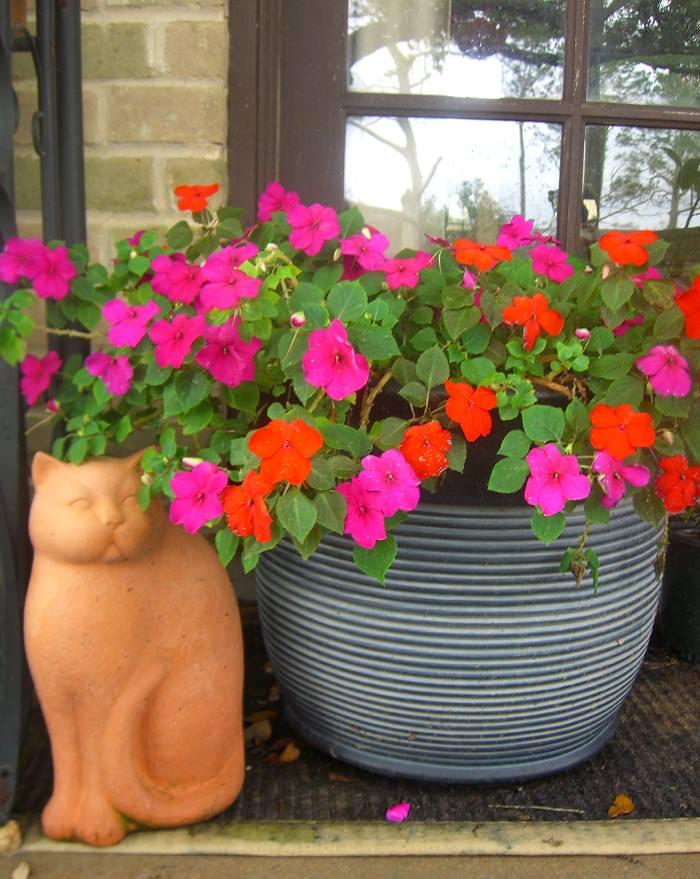
Impatiens are beautiful shade loving annuals but in optimum conditions, you can grow them year-round as a houseplant. Maintain room temperature above 50-55 F and place the pot in a spot that receives bright indirect sun all day long, it would be better if you can provide 1-2 hours of direct sunlight too.
10. Kalanchoe

Kalanchoe is a tropical succulent, plants of this genus grows best outdoors in warm climates. However, it can be grown indoors. This flowering succulent comes in a variety of colors and has low watering needs. You can keep it near a window where it can receive a few hours of sun in order to bloom.
11. Oxalis or Purple Leaf Shamrock

This beautiful flowering houseplant can adorn your house with showy purple foliage and white or pink flowers. Place it at a bright spot for abundant blooms and allow the soil to dry out between watering spells.
12. Cape Primrose

Cape Primrose or “Streptocarpus x hybridus” is a relative of the African violet. If you keep the soil lightly moist and give it bright, indirect sun year-round, it will bloom continuously. Also, there are many new hybrid varieties available with bigger flowers, longer blooming time, and more compact foliage.
13. Christmas Cactus

Christmas cactus is an old-fashioned favorite houseplant of many. When it blooms it creates a warm atmosphere. Red, pink, white or orange: The lovely flowers can quickly brighten up any interior. If maintained well, it can even bloom again from one year to another for years.
Also Read: How to Make Christmas Cactus Bloom at Christmas
14. Crown of Thorns

The Crown of Thorns becomes an exceptional houseplant due to its continuous blooms and low watering needs. If you can provide a sunny window where the plant can be placed, it will grow happily. Available in so many colors, the plant prefers loamy succulent soil and warm temperature.
15. Black Eyed Susan Vine

Black-eyed Susan vine can be grown indoors. Depending on your climate, this annual or perennial flowering plant can add a dramatic appeal to your rooms. Keep it near a window, where it receives a lot of sun.
Also Read: Best Indoor Vines
16. Purple Heart or Inch Plant (Wandering Jew)

A cluster of purple, lance-shaped leaves makes purple heart an impressive houseplant with or without its pink flowers. This beautiful trailing indoor plant can be grown in small colorful pots or hanging baskets and can be used as a table accent. Keep your purple heart (Tradescantia pallida) plant in a spot where it will receive 2-3 hours of sun for a healthy plant.
Note: Several other plants from this genus apart from Tradescantia pallida are known with similar names! For example, Tradescantia zebrina and Tradescantia fluminensis17. Orchids

Orchids are different from other houseplants. Unlike ferns, philodendrons, palms and Swedish ivy, orchids do not grow in soil. Putting an orchid in soil is actually one of the best ways to kill it. You can learn more about growing orchid indoors here.

Although begonias are considered as outdoor plants, there are many plants from begonia genus that makes great flowering houseplants. Most of them are easy to grow and good for beginners. Wax Begonia, Rieger Begonia, and Angel-Wing Begonia are among the best and most popular houseplants.
2. Bromeliads

Its colorful foliage and long lasting flowers can beautify any interior. It thrives easily without much care and the best thing is that you can grow this houseplant in low light conditions too.
3. African violet

African violets are easy to grow flowering plants that can be grown indoors for their beautiful flowers and foliage, they prefer warm climate rather than cold. Keep these plant in a spot where they receive filtered sun.
4. Scented Geranium

Scented geraniums with fragrant leaves and bright colorful flowers become incredible houseplants. However, growing geranium indoors is not as easy as other flowering houseplants we have here in this list. It requires a south or west facing window that receives ample sun and moderate watering.
5. Poinsettia

Growing poinsettias in your home can add a bright touch to your interior. Its multicolor bracts look more colorful than its flowers. This tropical plant requires, light, warmth and protection from drafts to thrive indoors.
6. Peace Lily

If you want to grow a low-care plant, grow peace lily. Inside your home, it can live without water for days. Peace lily’s beautiful white flowers flourish in low lighting conditions. It also removes the toxins from the air.
7. Lipstick Plant

Although not commonly grown as a houseplant, lipstick plant can be grown indoors. It requires constantly warm temperature and humid surrounding to grow and thrive. Here is more on how to grow lipstick plant.
8. Jasmine

Many jasmine varieties can be grown indoors. If you keep this most fragrant vine in a bright spot where it receives some hours of direct sunlight daily, it’ll grow. The selection of jasmine varieties you want to plant indoors depends on the climate you live in. For colder regions, Jasminum polyanthum is the one you can try, whereas in tropics most of the plants from this species will grow.
9. Impatiens

Impatiens are beautiful shade loving annuals but in optimum conditions, you can grow them year-round as a houseplant. Maintain room temperature above 50-55 F and place the pot in a spot that receives bright indirect sun all day long, it would be better if you can provide 1-2 hours of direct sunlight too.
10. Kalanchoe

Kalanchoe is a tropical succulent, plants of this genus grows best outdoors in warm climates. However, it can be grown indoors. This flowering succulent comes in a variety of colors and has low watering needs. You can keep it near a window where it can receive a few hours of sun in order to bloom.
11. Oxalis or Purple Leaf Shamrock

This beautiful flowering houseplant can adorn your house with showy purple foliage and white or pink flowers. Place it at a bright spot for abundant blooms and allow the soil to dry out between watering spells.
12. Cape Primrose

Cape Primrose or “Streptocarpus x hybridus” is a relative of the African violet. If you keep the soil lightly moist and give it bright, indirect sun year-round, it will bloom continuously. Also, there are many new hybrid varieties available with bigger flowers, longer blooming time, and more compact foliage.
13. Christmas Cactus

Christmas cactus is an old-fashioned favorite houseplant of many. When it blooms it creates a warm atmosphere. Red, pink, white or orange: The lovely flowers can quickly brighten up any interior. If maintained well, it can even bloom again from one year to another for years.
Also Read: How to Make Christmas Cactus Bloom at Christmas
14. Crown of Thorns

The Crown of Thorns becomes an exceptional houseplant due to its continuous blooms and low watering needs. If you can provide a sunny window where the plant can be placed, it will grow happily. Available in so many colors, the plant prefers loamy succulent soil and warm temperature.
15. Black Eyed Susan Vine

Black-eyed Susan vine can be grown indoors. Depending on your climate, this annual or perennial flowering plant can add a dramatic appeal to your rooms. Keep it near a window, where it receives a lot of sun.
Also Read: Best Indoor Vines
16. Purple Heart or Inch Plant (Wandering Jew)

A cluster of purple, lance-shaped leaves makes purple heart an impressive houseplant with or without its pink flowers. This beautiful trailing indoor plant can be grown in small colorful pots or hanging baskets and can be used as a table accent. Keep your purple heart (Tradescantia pallida) plant in a spot where it will receive 2-3 hours of sun for a healthy plant.
Note: Several other plants from this genus apart from Tradescantia pallida are known with similar names! For example, Tradescantia zebrina and Tradescantia fluminensis17. Orchids

Orchids are different from other houseplants. Unlike ferns, philodendrons, palms and Swedish ivy, orchids do not grow in soil. Putting an orchid in soil is actually one of the best ways to kill it. You can learn more about growing orchid indoors here.
1
2
文章
扭扭
2017年05月23日

Want to grow so many strawberries in so little space? Try one of these vertical DIY ideas for growing strawberries!
The fresh and juicy strawberries are one of the best fruits you can grow in containers
Also Read: How to Grow Strawberries
1. Vertical Strawberry Tube Planter
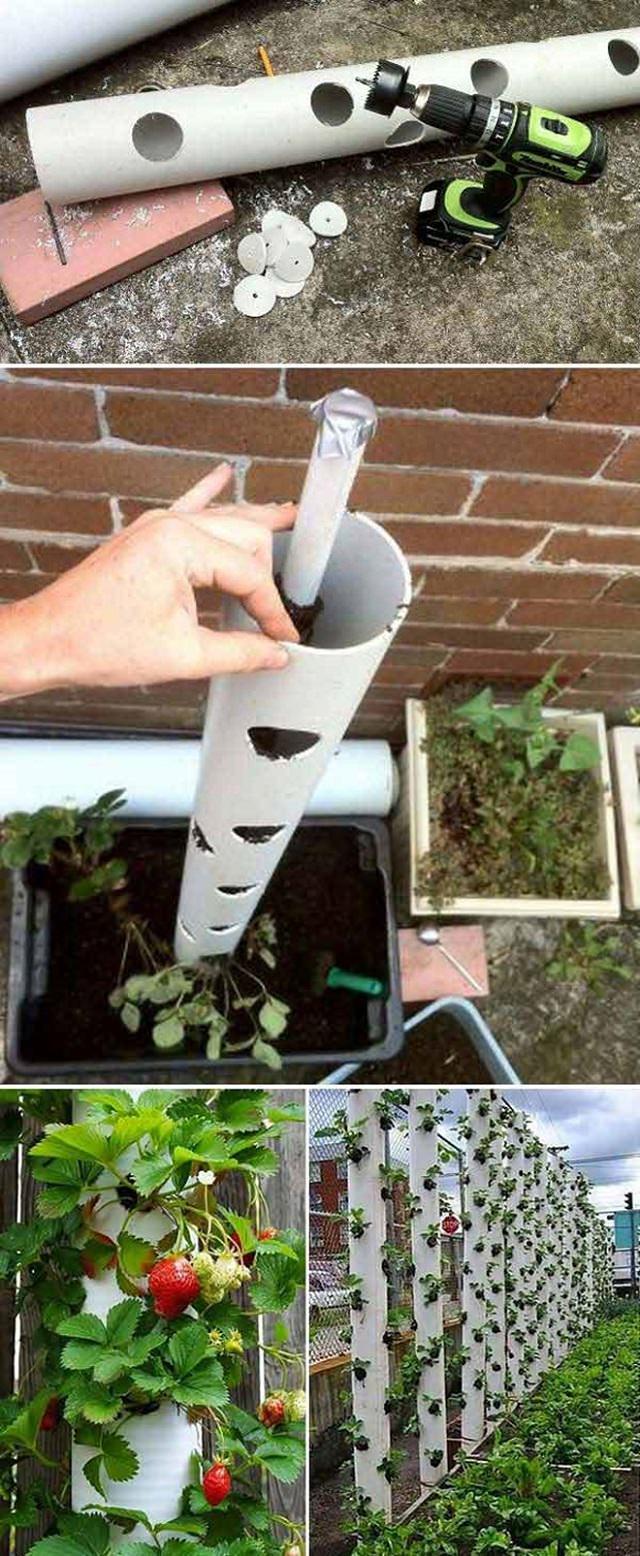
Ordinary PVC pipes are used for growing tons of strawberry plants in a small space, unbelievable. When you lack an appropriate garden space or yard, a vertical gardening idea like this can be tried. All you need for this DIY idea is a few PVC pipes, a drilling machine, and of course, some gardening essentials. Just keep in mind that vertical units require careful watering, so the last thing you would want is for them to dry out. The tutorial is available here!
2. Vertical Pyramid Planter

Go vertical, if you lack enough room to plant. A strawberry tower planter gives you the additional planting and growing space you need to showcase your love for this much-loved fruit. It’s an unusual and functional DIY garden project you can try. See the step by step DIY article here!
3. Hanging Basket

Growing strawberries in hanging baskets is possible and easy enough. An average-sized basket can fit a few strawberry plants. So, all you have to do is fill it up with the right rich potting soil and water regularly. That’s it! Check out the DIY tutorial on this site.
Also Read: The Right Time to Plant Strawberries
4. Strawberry Pallet Planter

A strawberry pallet planter is a clever idea to grow plants like strawberries that spread through runners; it also improves the productivity of this fruit. Pallets are cheap and sturdy; you can use them to create a raised bed like structure. Must see the tutorial post here!
5. Hanging Strawberry Planters

Growing strawberries up in the air in hanging containers is a simple and easy way to grow a lot of plants in a little to no space. Choose some big tin cans as a planter, also some cool color paint. This perfect idea of recycling used TIN CANS can be found here.
6. Strawberry Tower

A strawberry tower with an in-built reservoir is an excellent and unique way to grow juicy and fresh strawberries when you’re short of space. Easy to maintain, it is made of an array of plastic pots stacked up one on top of each other in the form of a tower. Also, the inbuilt reservoir makes watering a lot easier. This fantastic step by step DIY idea is curated from A Piece of Rainbow.
7. Strawberry Gutter Garden

Strawberries are super easy fruits to grow in gutters; it also saves them from diseases like crown rot and fruit rot. Also, this you can grow so many plants. See the step by step DIY idea with pictures here.
8. Stepped Strawberry Ladder

Not only the strawberries but you can also grow vegetables and herbs following this smart idea. You will need some help with the assembly process, though, as this is one of those DIY ideas for growing strawberries that need considerable effort. Once the structure is complete, fill up the planter boxes with the correct potting soil, seedlings and then watch them grow. The step by step article is available here.
Also Read: Vertical Garden Ideas for Small Gardens
9. A Strawberry Jar

A strawberry jar is a fun way to plant strawberries. After all, what is more, appealing than a nicely painted jar brimming with lush, green suckers and deep red berries. The one thing that makes these jars unique is that they have holes on their sides in addition to the top. This facilitates easy watering and proper care. To increase variety, plant another ornamental or edible plant, such as thyme or cilantro along with the strawberries, if you like. Click here to learn more this DIY idea.
The fresh and juicy strawberries are one of the best fruits you can grow in containers
Also Read: How to Grow Strawberries
1. Vertical Strawberry Tube Planter

Ordinary PVC pipes are used for growing tons of strawberry plants in a small space, unbelievable. When you lack an appropriate garden space or yard, a vertical gardening idea like this can be tried. All you need for this DIY idea is a few PVC pipes, a drilling machine, and of course, some gardening essentials. Just keep in mind that vertical units require careful watering, so the last thing you would want is for them to dry out. The tutorial is available here!
2. Vertical Pyramid Planter

Go vertical, if you lack enough room to plant. A strawberry tower planter gives you the additional planting and growing space you need to showcase your love for this much-loved fruit. It’s an unusual and functional DIY garden project you can try. See the step by step DIY article here!
3. Hanging Basket

Growing strawberries in hanging baskets is possible and easy enough. An average-sized basket can fit a few strawberry plants. So, all you have to do is fill it up with the right rich potting soil and water regularly. That’s it! Check out the DIY tutorial on this site.
Also Read: The Right Time to Plant Strawberries
4. Strawberry Pallet Planter

A strawberry pallet planter is a clever idea to grow plants like strawberries that spread through runners; it also improves the productivity of this fruit. Pallets are cheap and sturdy; you can use them to create a raised bed like structure. Must see the tutorial post here!
5. Hanging Strawberry Planters

Growing strawberries up in the air in hanging containers is a simple and easy way to grow a lot of plants in a little to no space. Choose some big tin cans as a planter, also some cool color paint. This perfect idea of recycling used TIN CANS can be found here.
6. Strawberry Tower

A strawberry tower with an in-built reservoir is an excellent and unique way to grow juicy and fresh strawberries when you’re short of space. Easy to maintain, it is made of an array of plastic pots stacked up one on top of each other in the form of a tower. Also, the inbuilt reservoir makes watering a lot easier. This fantastic step by step DIY idea is curated from A Piece of Rainbow.
7. Strawberry Gutter Garden

Strawberries are super easy fruits to grow in gutters; it also saves them from diseases like crown rot and fruit rot. Also, this you can grow so many plants. See the step by step DIY idea with pictures here.
8. Stepped Strawberry Ladder

Not only the strawberries but you can also grow vegetables and herbs following this smart idea. You will need some help with the assembly process, though, as this is one of those DIY ideas for growing strawberries that need considerable effort. Once the structure is complete, fill up the planter boxes with the correct potting soil, seedlings and then watch them grow. The step by step article is available here.
Also Read: Vertical Garden Ideas for Small Gardens
9. A Strawberry Jar

A strawberry jar is a fun way to plant strawberries. After all, what is more, appealing than a nicely painted jar brimming with lush, green suckers and deep red berries. The one thing that makes these jars unique is that they have holes on their sides in addition to the top. This facilitates easy watering and proper care. To increase variety, plant another ornamental or edible plant, such as thyme or cilantro along with the strawberries, if you like. Click here to learn more this DIY idea.
1
1




